
ON VIEW : ART OF THE DOG COLLAR | ON TOUR : RAPPAHANNOCK’S ARTISTS AUTUMN 2022 Foxfield Protected in perpetuity WHEN THE RODEO COMES TO TOWN Truffles The New Black Gold? Red Truck The “detail baker” is back
Middleburg, Virginia, (1787), is a charming Southern destination known as the nation’s horse and hunt capital. Set against the backdrop of the Blue Ridge Mountains, less than 50 miles from Washington, D.C., Middleburg offers the best of small-town America: local art, historic landmarks, and one-of-a-kind boutiques
If you love great food, Middleburg is the Southern food destination you have to know about. Our best restaurants are locally owned and offer everything from farm-to-table gourmet dining to hearty tavern fare, with locally made libations from the many wineries, distilleries, and breweries in the area.









f you’re looking to get away from the hustle and bustle, Middleburg is the ideal destination to relax. Whether you desire a 5-star luxury resort, charming country inn, or a peaceful bed and breakfast, you’ll find a place to rest here.
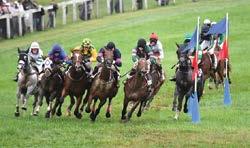
in support of the local business & retail community. The Middleburg Business & Professional Association 540 . 687 . 8888 www.visitmiddleburgva.com info@visitmiddleburgva.com Middleburg Virginia Historic Discover our traditions while creating your own... Not just weekends, but every day of the week
Jumping Rocks Photography VA Fall Races
Red Fox Inn VA Fall Races
Red Fox Inn
“The Hunt in Belvoir Vale” by John Ferneley Sr. Photo courtesy of National Sporting Library & Museum
your own Middleburg Moment
Jodi Miller Photography
Create
Check visitmiddleburgva.com for all of the amazing and fun events for you to enjoy. Looking forward to seeing you in the ‘burg!
Battle Run Hall, Washington


Built c. 1747, this classic Federal style fieldstone house is one of the earliest homes in Rappahannock County. Through the years it has been carefully added to and altered so it retains its original historic dignity while being comfortable and thoroughly modernized with current conveniences. The main house is three levels of antique charm with a dazzling English basement, 4 bedrooms, 5 baths and elegant porches. There is a stunning library/music room above the adjacent carriage house. The property includes an art studio, pool, pond, a historic log barn and gorgeous gardens under majestic old shade trees. $2,250,000
Thornton River Retreat, Sperryville





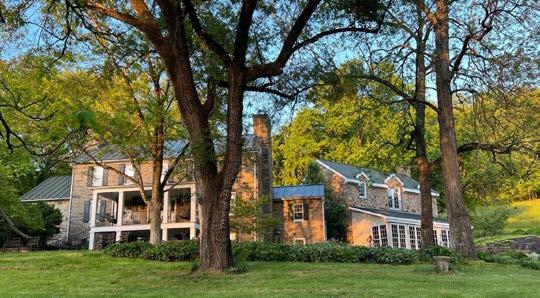


Thornton River Retreat is tucked away in a remote corner of the SNP where it borders the North Fork of the Thornton River. The 4 BR, 3.5 BA home is a soaring home with a massive fieldstone fireplace, exposed beams, heart of pine floors & an open floor plan. The eat-in kitchen features a farmhouse sink and ample cabinets. The screened porch, side deck and lower porch overlook a tree studded lawn as it rolls to the river. $1,125,000
Rediviva Retreat, Washington
Rediviva Retreat is an easy living home focused on the rolling farmland, shimmering ponds and endless views of the Blue Ridge Mountains. The 3 BR 3.5 BA home features spectacular living spaces, a gourmet kitchen and luxurious suites. There are porches, terraces and lawns on all sides. The 29-acre property includes 4 – 5 acres of forest, mature black walnuts, old stone walls, an intriguing but rustic little cabin and a portion of a large pond. $1,959,000

cheriwoodard.com
37 Main Street, Sperryville, VA 22740 540-987-8500 (office) 540-742-0833 (mobile)

M A R Y LAND WEST VI R G I N I A 15 15 15 15 50 50 17 17 29 33 33 29 29 1 1 17 522 211 522 340 66 81 81 66 95 95 95 95 64 64 495 495 Miles N S E W Rappahannock Fauquier Clarke Loudoun Prince William Stafford Fairfax Alex. Spotsylvania Fredericksburg Harpers Ferry Leesburg Ashburn Purcellville Middleburg Berryville Manassas Charlottesville Lovingston Palmyra Gordonsville Orange Madison Stanardsville Louisa Massaponax Culpeper Sperryville Warrenton Washington Marshall Gainesville Woodbridge Waynesboro Staunton Harrisonburg Front Royal Winchester Lake Anna D.C. Richmond Louisa Fluvanna Orange Culpeper Madison Greene Albemarle Nelson Bl u e R i d g e M o u n t a i n s P o tomac R. OccoquanR . Ma s s a n u tte n Mountain ShenandoahR. S h e n a n d o a h V a l l ey Rapidan R . Rivanna R . James R . R a p pahannockR . Potomac R .
“Affinities, not simply geography, create the Piedmont’s unique regional identity. We strive to give voice to this special — even magical — place in the hopes that it remains so.”
8 6 18 14 27 32 36 12 30 36 ON THE COVER
— Walter Nicklin, Piedmont Virginian founder
Walker Argenbright, 6 year old IMBA Mini Bull Rider from Amherst, VA, is one of four chosen to head to the World Finals in November.
Photograph by Camden Littleton
ART 6
Creativity across the Countryside
Artists of the Rappahannock

17th Annual Art Tour returns
27
“Identity & Restraint: Art of the Dog Collar” on view at the National Sporting Library & Museum
FOOD
8 Red Truck Farmhouse Cookbook
The “detail baker” is back and Mom’s Sour Cream Cake is in the contents
BY BILL KENT
FARM TO TABLE 22
The New Black Gold?
The Piedmont’s truffle growers aren’t to be trifled with
BY BILL KENT
WINE & OUTDOORS
12 Sips & Steps
Pairing Wine Tastings with Local Hikes
BY SCOTT ELLIFF AND ERIN GIFFORD
CONSERVATION
14
If These Stones Could Talk Finding beauty, respite, and quiet in a quarry
BY GLENDA BOOTH
EQUINE SPORTS
30
Saving Foxfield Albemarle County racecourse now protected in perpetuity thanks to its many ardent supporters
BY BETSY BURKE PARKER
36
When the Rodeo Comes to Town
Culpeper’s inaugural event was a rip-snorter
BY DIANE FARINEAU
18
Catastrophe
Warrenton’s Great Fire of 1909
BY JOHN T. TOLER
42
Building Schools Where There Were None
The Rosenwald Schools of the Piedmont
BY GLENDA C. BOOTH
DOGS
46
A Goodbye to Finn
1/11/2008 - 8/29/2022
 BY ED FELKER
BY ED FELKER
AUTUMN 2022 • VOLUME XVI • ISSUE 2 FEATURES
HISTORY
FOUNDING EDITOR: Walter Nicklin
CO-FOUNDERS: Arthur W. (Nick) Arundel, Sandy Lerner
PUBLISHER
Dennis Brack EDITOR
Pam Kamphuis
SENIOR EDITOR
Gus Edwards
FOOD EDITOR
Kaitlin Hill
SALES DIRECTOR
Jim Kelly
ACCOUNTING
Carina Richard-Wheat
CIRCULATION MANAGER
Jan Clatterbuck
540.675.3338
CONTRIBUTING EDITORS
Glenda Booth, Katilin Hill, Bill Kent, Camden Littleton, Jennifer Waldera
The Piedmont Virginian is published quarterly by Rappahannock Media, L.L.C. 309 Jett St., Washington, VA 22747 540.349.2951, pam@piedmontpub.com



Subscription inquiries: 540.675.3338
All editorial, advertising, reprint, and/or circulation correspondence should use the above address, or visit the website: piedmontvirginian.com
The editors welcome but accept no responsibility for unsolicited manuscripts and art. Reprints or bulk copies available upon request. Subscription rates: $29.95/one year, $49.95/two years.
© 2022 by Rappahannock Media, LLC.
ISSN # 1937-5409
POSTMASTER: Please send address changes to The Piedmont Virginian, P.O. Box 59, Washington, VA 22747.

4 PIEDMONTVIRGINIAN.COM | | AUTUMN 2022 Gilding,Carving, and Restoration ServicesOffered 1E.MainSt.,Berryville phmillerstudio.com 540-955-3939 OUR RANGE IS UNLIMITED: Renaissance to Federal to Contemporary Crafted right here in the Piedmont!
Glenda Booth, a freelance writer and editor who lives in Northern Virginia, writes about natural resources, historic sites, interesting people, public policy, travel, and other topics for magazines, newspapers, and online publications. She grew up in Southwest Virginia and received degrees from Longwood University and the University of Virginia.

Diane Farineau lives in Charlottesville, where she is at the permanent beck and call of her border collie, Frances. She spends her free time growing things, chasing brook trout, raising bees and occasionally getting to write about things that make her happy like music and outdoor adventures.

Kaitlin Hill is a Culinary Institute of America trained chef with a B.A. in history from the University of Richmond. After completing her culinary degree, she worked in New York as a professional pastry chef, recipe tester for Saveur magazine, and editorial assistant to renowned food critic Gael Greene. In 2015, she returned home to Washington, D.C., where she currently runs a catering business and works as a freelance writer and photographer.
The author of seven novels, a Fodor’s Guide and a history of Atlantic City, Bill Kent attended Oberlin College where he majored in English and Religion. His first journalism was for the Georgetowner. He went on to become a correspondent for the New York Times and a book reviewer for the Times, the Washington Post, the Philadelphia Inquirer and Kirkus Reviews. His writing has appeared in more than 40 regional and national publications. He has taught writing and journalism at the University of Pennsylvania, Rutgers and Temple universities.

Camden Littleton is a professional photographer and digital marketing consultant who lives in Charlottesville. When not photographing and creating content, she hangs out with her poodle, Grace (@ gracelittleton on Instagram) and explores menus, music, and mountains with friends and family throughout the Piedmont. She grew up in Middleburg and graduated with B.S. in communications from Appalachian State University.

Betsy Burke Parker is a journalist and photographer based in Rappahannock County. She’s served as Horse and Field Sports editor for Piedmont Media since the late 1980s, and as managing editor for inFauquier magazine for 10 years. Parker is also research writer for the National Steeplechase Association.



Broad Run resident John Toler is the co-author of the recent Fauquier County and Town of Warrenton history books, and has contributed numerous newspaper and magazine articles focused on the history of Fauquier, Prince William and Loudoun counties.




PIEDMONTVIRGINIAN.COM | | AUTUMN 2022 5 FABRICS UNLIMITED The Area’s Largest In-Stock Selection Better Decorative Fabric at Discount Prices 1st Quality only 3912 Seminole Trail, Charlottesville 22911 434-973-5641 ~ Monday-Saturday 9:30-5:30 www.fabricsunlimitedva.com Your Locally Owned Decorating Source Celebrating 50 Years 540.347.0555 528 Waterloo Road, Warrenton | warrentoneyes.com Dr. Shannon Moore | Dr. Lisa Butterfield | Dr. Barbara Masiello VOTED “Best of Fauquier” 9 Times! Serving Fauquier County Since 1979 Lifestyle BEST 20 22 THE 17TH ANNUAL OF FAUQUIER
CONTRIBUTORS
Creativity across
Rappahannock County artists open their studios in November as their 17th Annual Fall Art Tour returns
 PHOTOS BY JENNIFER A TEPPER
PHOTOS BY JENNIFER A TEPPER
Nearby Rappahannock County's fine artists, many of whom are award-winning and nationally recognized, are busy creating new works in a wide range of genres for next month’s Fall Art Tour.


BE A PART OF THIS EXTRAORDINARY 17-YEAR TRADITION: The combination of beautiful art and Rappahannock County’s stunning vistas, in the shadow of the Shenandoah National Park in prime leaf-peeping season, guarantees a fabulous experience for all. Come for just a day, or make a weekend of it by staying in one of our many inns, bed and breakfasts, and Airbnbs, so you can take advantage of our wonderful local restaurants, wineries, breweries, and more on your visit. Here’s what to expect when the annual event welcomes visitors:
SELF-GUIDED TOURs will take visitors through the scenic Piedmont countryside and charming villages en route to their favorite studios and galleries on November 5 and 6. This singular event thrives on the energies of the artists sharing their creative processes with visitors, a welcoming local community, and enthusiastic visitors who come from near and far.
A WIDE RANGE OF ART AND 80+ LOCAL ARTISTS: Nearly 40 studios and galleries featuring 80+ local artists are participating, with many returning artists and two brand new artist studios. You’ll see a wide range of art including paintings in all genres and mediums, furniture, drawings and engravings, sculpture, ceramics, mosaics, photography, printmaking, woodworking, jewelry, bookbinding, and stained glass and other glasswork. Two key recent changes that are continuing this year:
Most importantly, the Tour is free! Donations are always welcome, but not required.
Visitors can plan their own Tour, starting from any part of the county, studio or gallery. Maps will be available both online at FallArtTour.org, as well as at the Rappahannock Visitors Center and other local businesses. Check out the website for a sneak peek of what you’ll find in participating galleries and studios; each has their own feature page.
6 PIEDMONTVIRGINIAN.COM | | AUTUMN 2022 ART
the countryside
A SPECIAL EXPERIENCE, OPEN TO ALL: What makes the Fall Art Tour such a special event is the opportunity to visit with artists in their studios, see where they work and learn about their creative process. After meeting the artist, you may decide to take home a new piece of art based on a better understanding of the artist, the inspiration for the piece, and the artist’s technique. This event happens just once a year and many of these studios are only open to the public this one weekend each year.
TAKING THE TOUR: RAAC's 17th Annual Fall Art Tour, a free event, will take place on Saturday-Sunday, November 5-6, 10 a.m. - 5 p.m. both days. Go to FallArtTour.org to view participating artists and samples of their work and to get all the information you need to plan your own tour.

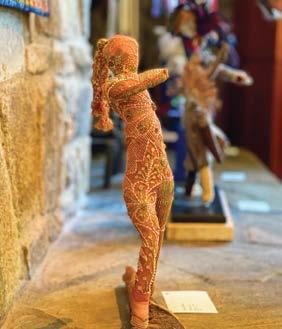





PIEDMONTVIRGINIAN.COM | | AUTUMN 2022 7
5 th & 6 th 37 Studios & Galleries | 80+ Artists Plan Your Self-Guided Trip Online FREE A DMISSION!
November
ART
Red Truck Farmhouse Cookbook

The “detail baker” is back and Mom’s Sour Cream Cake is in the contents!
BY BILL KENT
Among the mountain of fan letters that arrived after Warrenton’s and Marshall’s Red Truck Bakery founder Brian Noyes published his first cookbook was a letter from a reader who did not find the recipe for Sour Cream Cake. She would not have bought the book, she wrote, had she known that recipe was missing. She concluded with, “Please advise.”
Noyes’s advice: “Check the Contents page before buying a book.”

But he couldn’t forget the letter, never mind the fact that his book is a best-seller in its fifth printing. Or that his locally sourced, seasonally synchronized, made-entirely-on-site pies, cakes, breads, muffins, cookies, granola, soups, and sandwiches have been praised by Oprah Winfrey, President Barack Obama, Chef Jacques Pepin, and those peripatetic connoisseurs of road food, Jan and Michael Stern.
Nor could he forget that in the 15 years since the Monterey, Calif.-born son of a newspaper publisher left his day job as a graphics designer for the Washington Post’s Sunday Magazine and began selling baked goods from an old red Ford F-100 pickup truck he bought from fashion designer Tommy Hilfiger, his Warrenton and Marshall shops have joined the small list of American “destination bakeries” that are worth a trip to smell what’s in the ovens and taste what’s just come out.
Still, Noyes couldn’t put that letter out of his head.
So, just as the pandemic hit, Noyes thought he might put Sour Cream Cake, and other recipes, in a second book. “With more savory things than sweet, and with food that goes beyond what we do in the bakery that is comforting in a close, family-and-friends kind of way—with stories. If I’ve learned anything about living so long
in the South, it’s that people in the South are great storytellers.”
Each recipe would have a brief story about why this dish, pie, cake, or bread was important to him, his family, and friends— which would permit him to offer recipes from some of his favorite chefs and restaurants, such Corn Ice Cream from Ian Boden at Staunton’s The Shack; Wild Mushroom Tartines from William Dissen of Charlotte, N.C.’s Haymaker; and a summer gazpacho recipe that friend and Washington Post food critic Tom Sietsma coaxed from a cook at an unnamed “dive” in Georgetown.
He would dedicate it to his late grandmother, Willmana Noyes, who used to tell him stories in her kitchen in Hendersonville, N.C., and inspired him to become a baker.


Three years later, Mom’s Sour Cream Cake is one of 95 recipes (more, if you count the variations) in Brian Noyes’s The Red Truck Bakery Farmhouse Cookbook.
Add to that salted caramel apple pie, and what might be Noyes’s masterpiece, a Virginia peanut pie whose initial recipe dates back to the mid 19th century that he worked on obsessively until he got
8 PIEDMONTVIRGINIAN.COM | | AUTUMN 2022
FOOD
Noyes wrote, “For four generations, this white cake with a Swiss meringue-type frosting that has melted chocolate poured over the top was trotted out for birthdays in the Noyes family.” The recipe was found in Noyes’s grandmother’s spiral-bound recipe book in her handwriting and contained instructions such as “add butter the size of a walnut.” Noyes has tweaked the directions for the modern cook.
it right. Made with apple cider, sorghum syrup, hickory syrup, hot spiced honey, shredded coconut, crumbled chocolate cake, and big roasted Virginia peanuts, the pie’s complicated flavor tastes nothing like a typical corn syrup nut pie and was selected as the best in Virginia in the Thanksgiving 2021 issue of Food & Wine magazine.
To make sure he could make all of his recipes in a reasonably simple kitchen, Noyes confined himself to his 1860 Orlean farmhouse (hence the farmhouse in the title), where he baked the first goodies that he sold from his truck. While there, Noyes slipped and hit his shoulder. “I was pretty badly damaged, so I had to get my right shoulder replaced, in a hospital, while Covid was going on all around me.”
After the operation, he wrote most of the book one-handed. Then his hip gave out while painting the floor of his farmhouse. After a hip-replacement, he was crossing a street in Arlington (where he shares a rowhouse with his partner, Dwight McNeill), and was run over by a bicyclist. That led to a concussion and, ultimately, a knee replacement.


“The last time I was in a hospital was the day I was born,” grumbles Noyes, 65. “I told the doctor I used to walk seven miles to and from my job at the Washington Post. He told me that walking all those miles was the reason I needed a knee replacement.”
One almost miraculous incident occurred after he had finished writing. He had wanted to include a recipe for the Noyes Family Birthday Cake, a white cake with Swiss meringue covered in




PIEDMONTVIRGINIAN.COM | | AUTUMN 2022 9
BY LUKE CHRISTOPHER (2)
BY LUKE CHRISTOPHER
BY ANGIE MOSIER
melted chocolate. He tried to make it himself but the taste wasn’t quite right. He reached out to every member of his family. No one had a copy of the recipe.
Then, when moving a stack of books, he dropped the pile and there, somewhere around the bottom, was Grandmother Wilmana’s recipe book. He found the recipe, baked the cake, tasted it, and managed to slip it into the book.
Months followed when he made each recipe several more times for the photographs, most of which were done at his farmhouse (some of the landscape photos were taken at the nearby home of folk singer Mary Chapin Carpenter, a friend). Some of the items included in the photos are from his antique collection. Others came from friends.
Noyes did not design the book himself, but approved of the result.
“Graphic design and baking come together when you consider that how something looks has a lot to do with how you approach it, use it, and enjoy it than is immediately obvious,” he explains, pointing to how the horizons line up on the framed photographs hanging on the dining room wall inside his Marshall bakery. “It’s okay if nobody notices that. I do.”
Noyes is a detail baker. What appears to have been whipped up in a country kitchen is very well thought out, the result of long hours of experimentation and Noyes’s personal taste. While a basic pie crust is easily constructed from flour and butter, lard, or shortening, and a pinch of salt, Noyes’s recipe (repeated from the first book) includes an egg yolk, lemon zest and orange zest. This gives the Red Truck pies a dark, firm, slightly tangy crust that encloses
Left: Wild Mushroom Tartines with Black Pepper Ricotta. An open-faced sandwich with with wild mushrooms and homemade ricotta. Noyes advises: “True wild mushrooms are foraged, but you might be able to find them at farmers markets and specialty stores. But a mix of porcinis, shiitakes, oysters and creminis will also work well. While store-bought whole-milk ricotta can be substituted for this lunch treat, making delightfully fluffy ricotta at home couldn’t be easier.”

Above: Butternut Squash Soup with Apples, Pears, and Pecan Butter. A favorite among Noyes’s Washington DC friends, this soup tastes like autumn in a bowl. Consider serving in carved-out mini-pumpkins for a fall touch.

the fillings with an added richness and texture.
“People ask me all the time how many pies we sell for Thanksgiving. I’m happy to say, ‘all of them!’”
Noyes’s attention to detail is evident in his sandwiches. Pickle slices give the Red Truck’s meatloaf sandwich a subtle sweetness when eaten cold. He likes food to have an unexpected, if not downright surprising flavor, especially with meatloaf, another recipe in the book. “I make no apologies for meatloaf,” he insists. “I was raised on it, and it can be done right.”
The pot pies, pork tenderloin, baked and roast chicken, mushroom lasagna, and other savory main dishes that would not be served in a bakery might make people wonder if Noyes may be thinking of applying his clean, detail-oriented, ineffably delicious attention to a restaurant.
“Oh no, I could never do that,” he insists. “Too much work.”
For much of the last decade, he has turned down offers to open a third Red Truck Bakery in Virginia, Maryland and elsewhere. Is it coincidental that his cookbook tour will take him to some of those locations?
“Never say never,” he adds.
redtruckbakery.com
10 PIEDMONTVIRGINIAN.COM | | AUTUMN 2022
FOOD
BY
ANGIE MOSIER (2)
Red Truck Bakery Farmhouse Cookbook © 2022 by Brian Noyes.
Photographs © 2022 by Angie Mosier. Published by Clarkson Potter, an imprint of Random House.



SIPS
&
For more than two years now we’ve been learning how to adapt to Covid. All small businesses, like our little DuCard Vineyards in Etlan, Madison County, were terrified by the uncertainty of whether we would survive and, if so, how we would need to change our operations to be a safe and attractive place to visit.
Well, two years later, we’re still here, with thanks to everyone for their support.
What have we done that’s new and different?
Hiking
Lots of people discovered the great outdoors during Covid. With nothing else available, let’s go take a walk in the woods—fresh air, no crowds, good exercise, and more. Well, we just happen to border the Shenandoah National Park, with some of the best hikes around. What a great combination: take a hike, maybe climb a mountain, and then have a celebratory wine flight on our back lawn. No, we don’t have a dress code—hiking clothes are chic as far as we’re concerned. P.S. It works better if you hike first and then come for a flight of wine.
Flights
We overhauled how people sample our wines. We eliminated crowded stand-up tastings of small sips of wine at the bar and moved instead to providing a flight of four wines, served while seated at your table, in Riedel crystal glassware, by staff who can focus exclusively on you. A hugely upgraded experience. The tasting room became sort of a drive-through—order and go find a table on the patio or lawn— and we’ll bring the wines out to you. And
STEPS
Pairing Wine Tasting with Local Hikes

 PHOTOS BY ERIN GIFFORD
PHOTOS BY ERIN GIFFORD
we deliver to your table with the return to indoor seating as well—it’s just a more elegant and high service approach overall.
Year-round outdoor relaxation

The urge to get out of the house was especially strong during the winter months of Covid—we all felt so cooped up. So we added fire pits, blankets, and space heaters so that, shivering or not, as long as the roads were passable, folks could come out for a change of scenery, fresh air, and a few pops.
Weekdays
Hey, during Covid if you didn’t have any Zoom calls on a random Tuesday, it was pretty appealing to get in the car and go out to the country. So we’re now open seven days a week. Frankly, with a smaller crowd—or no crowd—on those days, we can have more one-on-one interaction, talking about the wines and our history, answering questions, and getting to know our customers.
Alumni group ‘virtual tastings’
Colleges quickly understood the difficulty of keeping alumni engaged and in the fold for fundraising, among other things. What!? No college football Saturdays and no class reunions! So we were asked to host alumni group sessions with our wines shipped out to participants who dial in on Zoom to taste the wines, hear us talk about them, and answer questions. Hey it’s not the same as the class tailgate in the stadium parking lot, and the Zoom technology was pretty sketchy when we first started, but it turned out to be a fun way to keep the bond alive with the old U crowd.
While we hope, of course, that Covid will finally, really, this time, be completely behind us, these changes to our operations will remain, and we invite you to come out and see them for yourself. You know, on a day when you have no Zoom calls.
— By Scott Elliff
WINE
There’s something special about a glass of wine after a satisfying hike. Thankfully, Shenandoah National Park has more than a few good trails for hikers of all levels. Whether you want to climb to summit views or splash in waterfalls, you are covered. With a glass of wine, too.
Here are three hikes that pair perfectly with a glass of wine, and all are 15 minutes or less from a crisp Chardonnay or an aromatic Cab Franc.
EASY: Lower Whiteoak Falls (2.8 miles, out-and-back)

For an easy hike with a big reward – as in, a tumbling waterfall with a refreshing swimming hole – make a beeline for the White Oak Canyon Trail. This hike begins from the front of a large parking area on Weakley Hollow Road in Syria.
The trail starts to the right of the ranger station. Follow the blue blazes for the White Oak Canyon Trail. Stay alert and keep right when you reach a fork early in this hike (the trail on the left is the Cedar Run Trail). For much of the hike, you’ll walk along the gently-flowing Robinson River.
There are a couple of easy water crossings on your way to the falls and a mild elevation gain of just over 400 feet. You’ll reach Lower Whiteoak Falls at the 1.4-mile mark. Take your shoes off for a splash or settle in on a rock for a snack.
From here, the trail continues on to Upper Whiteoak Falls, but the trail also gets much more steep. From Lower Whiteoak Falls, re-trace your steps to the trailhead. In
winter, you may see frozen icicles dangling from exposed rocks.
MODERATE: Corbin Cabin (8.4 miles, out-and-back)
The hike to Corbin Cabin by way of the blue-blazed Nicholson Hollow Trail is a quiet, forested hike through the woods. For this hike, you’ll park in the Old Rag parking area (lot two is closest to the trailhead) on Nethers Road in Etlan.
Early in this hike, you’ll encounter two water crossings. You’ll step on large rocks to cross over Brokenback Run. In a few more steps, you’ll hop-scotch across the Hughes River. From here, you’ll hike parallel to the Hughes River for nearly the entire way to Corbin Cabin.
At the 2.7-mile mark, you will arrive at a swimming hole. It’s a fantastic spot to take a break to re-fuel or re-hydrate before the final push to Corbin Cabin. Up to this point, the trail has been relatively flat, but it’s mostly uphill from here to the historic chestnut log cabin.
Corbin Cabin is one of six primitive cabins within Shenandoah National Park that are owned and managed by the Potomac Appalachian Trail Club (PATC). The fourroom cabin can be rented out from the PATC for $35 per night during the week or for $50 per night on weekends.
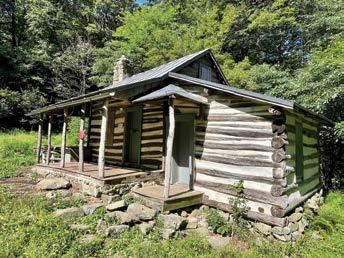
STRENUOUS: Old Rag (9.8 miles, loop)
The exhilarating 9.8-mile Old Rag hike is a crowd-pleaser, but it's not for everyone.
One mile of this loop hike is a rock scramble that requires hikers to navigate cramped spaces and shimmy down granite surfaces. Thankfully, spectacular 360-degree panoramas await from atop Old Rag.


There’s plenty of space to sit and revel in the views of surrounding mountains.
For this hike, park in lot one in the Old Rag parking area on Nethers Road in Etlan. The hike begins to the left of the ranger station. Note that you may need to plan ahead for this wildly popular hike. A new pilot day hiking ticket program went into effect this year and runs through November 30.
All hikers must purchase a day-use ticket to hike Old Rag for $1 at www.recreation. gov. Given cell service is largely non-existent in the Old Rag parking area, you’ll want to buy your pass ahead of time. No day-use tickets are sold on-site and dogs are not allowed on this hike.
HIKING TIP
Don’t count on your phone: Cell service for each of these hikes ranges from spotty at best to completely non-existent. If you plan to hike Old Rag, take a screenshot of your day-use ticket for the ranger on duty.
— By Erin Gifford
OUTDOORS
Lower Whiteoak Falls
Corbin Cabin
If These Stones Could Talk
Finding beauty, respite, and quiet in a quarry
 STORY AND PHOTOS BY GLENDA C. BOOTH
STORY AND PHOTOS BY GLENDA C. BOOTH
Pointing at a clump of two-inch green stalks growing in only about a quarter inch of grit in a soapstone rock, Bernice Theiblot told her visitors, “That’s a quill fameflower. It grows in barrens. Its fuschia flower blooms after 2 p.m. and at dusk it’s gone,” she explained. Further along a woodsy trail, as the group edged past some soapstone boulders, she said she had recently seen kitten scratches on the rocks, bobcat kittens.
These are but two of the many intriguing delights at the unique Quarry Gardens at Schuyler in Nelson County. The 40 acres of gardens are nestled in and around a soapstone quarry that was mined between the 1950s and ‘70s. Where once there was a cacophony of cranes and heavy machinery extracting soapstone, today the quiet of the quarry is punctuated by rustling leaves, chirping birds, calling frogs and pollinators flitting from flower to flower.
Armand and Bernice Thieblot bought the property in 1991 and readily imagined its potential for gardens brimming with native plants
and gentle trails. But because for a decade after the quarry’s closure it was a dumpsite, they first had to haul out tons of trash, including refrigerators, car parts, washing machines, tires, and box springs.
From 2014 to 2017, the Thieblots prepared plans, enlisting Land Planning and Design Associates of Charlottesville to create a master plan. They also engaged Devin Floyd, of the Center for Urban Habitats in Charlottesville, to help conduct surveys of biota and to design and install the gardens.
The Quarry Gardens at Schuyler opened in the spring of 2017. Today, there are around two miles of walking trails, 34 outdoor galleries of native plant communities, and a visitor center featuring exhibits on native plants, local ecosystems, and the history of Schuyler’s soapstone industry. The nonprofit Quarry Gardens Foundation manages the gardens.
Nelson County resident Connie Brennan was awed during her first walk there. “Standing among the huge soapstone quarries enveloped

14 PIEDMONTVIRGINIAN.COM | | AUTUMN 2022 CONSERVATION
Quarry ponds and walls at the Quarry Gardens at Schuyler in Nelson County
by lush native plant gardens is a magical experience,” she commented.
In 2015, the Theiblots placed a 400-acre buffer around the gardens with a conservation easement, and in 2016, then-Gov. Terry McAuliffe designated it a Virginia Treasure.
What’s There?
About 12 miles east of U.S. Route 29, the gardens are at their height between April and November. While the soapstone deposits were once gouged out by the quarriers, nature is always renewing.

Two distinct geological formations underlie the gardens. The site’s wide variations in elevation, soil, moisture, and history of disturbance result in an array of ecosystems. Habitats include prairie, butterfly and pollinator gardens, wetlands, vernal pools, barrens, a fern gully, and a waterside talus.
Along two miles of trails that wind around two quarry pools, visitors can explore seven ecozones. The owners’ long-term goals are to protect habitats, advance succession, and build out native plant communities in 14 ecozones and seven conservation areas immediately surrounding the quarry pools.


The Theiblots are both preserving established native plant communities and introducing additional native plants endemic to within 15 miles of the site. To choose appropriate plants, they first studied what was there: trees, shrubs, plants, fungi, reptiles, amphibians, insects, birds, and other wildlife. Surveyors found more than 850 species, including some 550 flora (503 native) and 300 fauna. This included 56 species not previously reported in
You envision it. We build it.




PIEDMONTVIRGINIAN.COM | | AUTUMN 2022 15 540-338-2306 | 800-432-3864 | Fax: 540-338-3015 | Sales@FuogInterBuildInc.com P.O. Box 237, Purcellville, VA 20134 | www.FuogInterBuildInc.com Authorized Butler Builder NOW CELEBRATING 41 YEARS SERVING OUR CUSTOMERS !! Post Frame Construction & Metal Buildings Horse Barns, Arenas, Garages, Hobby Barns, Wineries Pre Engineered Metal Buildings Authorized Butler Builder, Commercial, Industrial, Agricultural Site Work Excavation, Roads, Outdoor Arenas, Water, Sewer, Ponds, Storm Sewer, Commercial, Residential, Industrial, Agricultural
• Award winning builder with national recognition • Expert staff implementing smooth projects from start to finish • Excellent work at best possible price
Nelson County. They believe the total number of species exceeds 950. They have integrated nearly 50,000 plants of 198 species into the outdoor galleries, making the site the largest assemblage of native species of any botanical garden in Virginia.

Among many other native plants are showy orchis, larkspur, pussytoes, royal ferns, columbine, and pickerelweed. Visitors are wowed by trilliums, wild geraniums, mayapples, wild ginger, and coreopsis. Inside a deer enclosure, woodland flax and golden Alexanders grow.

“The Quarry Gardens at Schuyler are a wonderful celebration of locally native plants in such a naturalistic setting that the visitor doesn't realize the work involved to make it look effortless,” offers Nancy Vehrs, president of the Virginia Native Plant Society
In addition to plants, visitors may get glimpses of turkeys, groundhogs, foxes, frogs, skinks, snakes, raccoons, deer, and up to 90 species of birds.
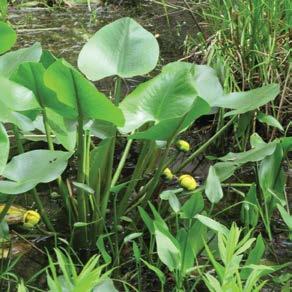
Soapstone Quarrying

The garden is in what geologists call a “soapstone belt,” one of only three large soapstone deposits in the world. The other two are in Finland and Brazil. Soapstone is a metamorphic rock that is nonporous, heat resistant, and named for how it feels, velvety or soapy to the touch. Native Americans carved bowls out of it
and used it for cooking slabs because it radiates heat. At one time, many American schools had soapstone lab counters and homes had soapstone laundry tubs.
Spotting a soapstone outcropping in 1884, some enterprising businessmen founded the Alberene Stone Company, which boasted some 2,000 employees at its peak in 1920. There were once 14 houses on the property.
The quarry workers hauled away 800,000 pounds of soapstone and left 800,000 pounds. For commercial purposes. They considered the ideal size to be four-by-six-by-eight-foot blocks, so today, many discarded soapstone chunks are scattered around the quarry pits. Other evidence of quarrying includes the base of a crane platform, a rotting workman’s bench, and a pre-1969 sardine can embedded in a devil’s walking stick tree.
The backdrop of soapstone blocks and sheer walls offers a dramatic geometric aesthetic and some are now being colonized by plants and animals. Two quarries hold 45 feet of virtually still water below 45-foot rock walls.
In the visitor center, a converted Quonset hut, exhibits explore
16 PIEDMONTVIRGINIAN.COM | | AUTUMN 2022
Clockwise from top left: Bernice Thieblot points out the quill fameflower growing on an excavated soapstone block; Spatterdock, a wetland plant, with yellow golf-ball-size flowers; The walking trail through the gardens
the history of Schuyler’s soapstone industry and include samples of rocks and artifacts found on the site as well as an operating model of the 17-mile-long Nelson and Albemarle Railroad, which carried the stone and products to the Southern and the Chesapeake & Ohio lines.
The gardens and quarry blend beautifully to create a tranquil, verdant preserve offering many lessons in geology, botany, history, and more.


TO VISIT
quarrygardensatschuyler.org
• Visiting is by appointment only. Open April to November. In those months, something is always in bloom.
• A regularly scheduled guided tour is $10 for adults, $5 per child age 10 or under. Owners can arrange private tours which require a donation.
• The total site of 600 acres has 13 miles of trails and more than 160 steps. A road around the property allows people with disabilities to visit parts of the site.
• Address: 1643 Salem Road, Schuyler, Va. 22969


PIEDMONTVIRGINIAN.COM | | AUTUMN 2022 17 As always: widely spaced, fresh air, tranquility Open through the winter, 7 days/week Fireplace inside | Solo stoves and blankets on the patio Music (and food) every Saturday 2:30-5:30 | Lots of special events ongoing Reservations recommended – via website DuCardVineyards.com | 540-923-4206 | Madison, VA
Multiple Gold Winner
CONSERVATION
Catastrophe: Warrenton’s
Great Fire of 1909
BY JOHN T. TOLER
At about 7:40 p.m. on the night of November 22, 1909, a fire started in the hayloft of the Bradburn & Clatterbuck Livery Stable on present-day Ashby Street, near the corner with Lee Street. The cause of the fire was never determined, but the first witnesses on the scene were met by tongues of flame shooting out of the hayloft, and a high wind was blowing.
Most of the town’s firefighters were in town, either at a revival at the Methodist Church on Culpeper Street or at the Post
Office waiting for the mail. They responded quickly when someone rang the Courthouse bell. But their efforts to battle the blaze quickly failed due to a lack of water.
At the time, Warrenton was served by a reservoir on View Tree Mountain. The dam had been rebuilt, but a leak had developed at one end of the dam, and the gravity-flow of the water was minimal. That problem, plus the fact that the region was in the grips of a fall drought, created a “perfect storm.”
The fire spread from the livery stable to the adjoining buildings, with flames raging
View from Ashby Street, where the fire started, shows the extent of the destruction. Buildings on Waterloo Street and Courthouse Square were lost, but through heroic efforts, the Courthouse and county jail were spared.

up Ashby Street toward Waterloo Street, Court House Square, and Winchester Street. The next structure to ignite was the adjacent Ullman stable, followed by W. A. Garner’s skating rink. Soon the Farmers’ Hotel at the corner of Main and Ashby streets was threatened.
Across Ashby Street, the Warren Green Hotel annex was being hit by windblown, burning embers, and the stone walls of the county jail began to heat up. Blown by the wind, the fire spread across Court House Square to Winchester Street. Across from the
18 PIEDMONTVIRGINIAN.COM | | AUTUMN 2022 HISTORY
Farmer’s Hotel, the almost-new Warrenton Municipal Building was soon ablaze.
Many more men rushed to town to help, including a detachment of cadets from Bethel Military Academy who marched in double-quick. But without water there seemed to be little they could do.
Frustrated, the firemen dropped their hoses and took buckets from stores and dwellings to form bucket brigades, using sand and water pumped from wells. But there was no stopping the flames. Chaos reigned as burning debris blown by the wind fell everywhere.
Fearing for his inmates’ safety, the county jailor released eight prisoners without handcuffs or manacles from the jail, and moved them to safety. None tried to escape.
Irvin Garrett remembers
Irvin Garrett was four and a half years old at the time of the fire, and in an interview
with the Fauquier Historical Society more than 70 years later, he recalled many details. It was after dark, and Irvin and his sister Esther were at home on Waterloo Street with their aunt, Hattie Burgess Cropp, while their mother Lelia Garrett was at the
revival at the Methodist Church.
When it was apparent that a huge fire was happening nearby, their Aunt told the children to go up to bed, but instead, they hid under the dining room table. “This turned out to be very fortunate for us,” Garrett recalled. The fire soon spread to the roof of the house, and they ran outside.
“How my aunt, my sister and I became separated, I do not know… but Esther took off by herself to find our mother at the church,” Garrett recalled. “I remember watching tar paper roofing, on fire, being blown through the air and igniting everything on which it lit. I also remember the dozen or so horses from the livery stable stampeding through the Square.”
“I ran across the street approximately at the location where the John Barton Payne Building stands to the area in front of the Old Jail. From there, Mrs. Addison Weeks led me to safety at the home of Mr. Ernest Ash.”

Dynamite
Having exhausted all other firefighting means, it was decided that the only way to stop the flames was to create fire breaks by dynamiting the structures immediately in the line of the fire. Firemen secured a 500-lb. cache of explosives from Paul C. Richards, the contractor building the new road to Bethel, and they began containing the flames by flattening the buildings in the way, creating fire breaks.

One of the first buildings to be demolished was the 2-story Warren Green Hotel Annex, creating a break that saved the main part of the hotel and the businesses on Culpeper Street.
The report published Nov. 24, 1909 in the Baltimore Sun recounted the heroic
PIEDMONTVIRGINIAN.COM | | AUTUMN 2022 19 HISTORY
Sanborn Insurance Company map drawn before the fire was shaded in blue indicating the areas devastated in the 1909 fire.
COURTESY OF THE FAUQUIER HISTORICAL SOCIETY.
Devastation of the west end of Warrenton on Winchester Street was complete. Only the shell of Carter Hall and the chimney of Britton Hall still stand after the fire burned out.
actions of C.C. Waugh, “…a strapping worker in the construction department under Mr. Richards,” who was credited with stopping the spread of the blaze by blowing up Mrs. H.A. Parker's house with 50 pounds of dynamite before the fire reached it.
“If Waugh worked quickly enough, he knew he could save the eastern and business sections of the town. He set the pasteboard boxes of dynamite inside the cellar, and then looked about his pockets for a fuse. “He had none, but knew that if he went for a fuse he would not have time to come back because the house would be off. He knew that if he had the fuse at that minute, the house would be down before the fire reached there, and the flames could not leap the breach.
“Unhesitatingly, he wrapped a bunch of newspapers tightly in his fingers and set a match to them. Glancing at the cellar door and gauging the distance, he leaned over, cat-like, and threw the blazing papers at the dynamite. He figured that it would take several seconds for the flames to eat inside the pasteboard, and he took a chance that those two seconds would give him his life. As he jumped out of the cellar and darted across the street, the flying debris of the house, following a terrific detonation, fell about him, and he was thrown 20 feet across the road. He scrambled to his feet unhurt.”
Acts of bravery
There were other acts of bravery. Charles Marshall grabbed a fire extinguisher and climbed to the roof of the Post Office at the corner of Main Street and Alexandria Pike. Every time an ember landed on the roof, he put it out.
“At her home on Waterloo Street, a woman was in bed with her two-day-old infant beside her,” according to the story in the Baltimore Sun. “The fire had started to eat its way up the back porch. The cry rang out around the burnt district until it was heard above the roar of the flames, ‘A woman is in danger!’ A dozen men rushed to the house, emerging a moment later carrying the mother in their arms, and a giant Warrentonian bore the babe with careful tread behind.”
On Winchester Street, the home of Dr. Carter was aflame, and the fire spread across the street to Capt. Edward Carter’s house, Carter Hall. Several boarders lived there, and they tried to save what possessions they could by throwing them out the windows, where the Bethel cadets moved them to safety.
By 11:30 a.m. the next day, it appeared that the fire was burning itself out, and in light of the danger and extreme efforts, no one was killed, and injuries were minor. But the damage to the west end of Warrenton was
extensive, and 14 families were left homeless.
No fewer than 26 buildings were lost, including the new Municipal Building, the skating rink, the Five Points Building and the Farmers’ Hotel. Fortunately, the books owned by the Warrenton Library Association that were stored in the hotel were removed by volunteers to the California Building before the fire consumed the building. Remarkably, the old Moses Hall on Waterloo Street was spared while adjacent buildings were lost.
The total damage estimate was $125,000, with about $80,000 covered by insurance. Damage to Carter Hall was set at $10,000, while the relatively new Town Hall was valued at only $2,500. The T.E. Pattie general store on Winchester Street and all of its contents were lost, valued at $12,000.
The greatest single loss was the studio of artist Richard Norris Brooke. While the building was only valued at $2,000, the value of the paintings lost in the fire was set at $25,000, and only partially insured. Another significant loss was the small building on Waterloo Street that housed Chief Justice John Marshall’s law office from 1788 to 1780.
While some blame was placed on the Town Council for not having the leak in the reservoir fixed before the fire, most understood that the extent of the disaster was unavoidable, and could have been much worse. A number of new ordinances were enacted, including forbidding smoking in or near any public or private stables. Fire lines within which frame structures could not be built were established, and the possibility of adding a chemical firefighting engine was explored.
A small shed in which to store the town's firefighting equipment was built on the site of the burned Municipal Building, and a new Town Hall at Main and Fourth streets was remodeled with offices upstairs and fire department on the ground level, an arrangement that would work for many years.
“We will have a newer and a better Warrenton,” wrote Capt. Fielding L. Poindexter, editor of the Warrenton Virginian. “The spirit of our town will assert itself as it did in Baltimore, and we will rebuild upon the ashes.”

20 PIEDMONTVIRGINIAN.COM | | AUTUMN 2022 HISTORY
Main Street Warrenton about 1908, looking west toward the Fauquier County Courthouse at left, and the new Municipal Building on present-day Courthouse Square.
Warrenton rebuilds, prepares
The buildings may have been lost, but the prime locations remained, and over the next few years, new structures did “rise from the ashes.” The Warrenton Supply Co., incorporated in December 1913, was built on the site of the livery stable and skating rink, and was soon selling Studebaker, EMF and Allen & Stanley Steamer automobiles.
A new Municipal Building, also known as “The Opera House,” was erected on Courthouse Square, along with new retail stores. The Warren Green annex was rebuilt, and although it was severely damaged, the brick walls of Carter Hall were still sound and the historic home was rebuilt. Across Winchester Street, homes and the new Warrenton Methodist Church rose from the ashes.
The town council purchased its first piece of motor-driven firefighting apparatus in 1921, a Chevrolet truck equipped with a 50-gallon chemical tank and a hose carriage costing $2,815.
William G. Bartenstein was appointed chief by the town council in 1922, and
in 1924, Chief Bartenstein, B. H. Smith, Alex Hamilton, Alwyn Ash, Lester Burke and Irvin Garrett, then 19 years old, met to discuss organization of a fire department. Young men of the town responded enthusiastically to the invitation to join.
The fire department was given space on the ground floor of the Town Hall in space used to store a steamroller, and after much work, it was made usable for the firemen. The fire alarm was a steam whistle located down the hill at the Warrenton Electric and Ice Company owned by M.J. O’Connell. The plant operators sounded the alarm – a short blast for a fire in town, a long blast for out of town.
On Dec. 3, 1924, the formal organizational meeting was held, with Mayor Thomas E. Frank presiding. W. G. Bartenstein was formally elected chief, A.S. Hamilton first lieutenant, Alwyn Ash second lieutenant, Lester Burke, president, Irvin Garrett secretary-treasurer, and C.C. Burke official truck driver.
Members paid dues of 10 cents a month, or $1 per year. Regular drills were held, and
soon they were able to demonstrate their expert hose work to the town council.
The infant fire company’s first fundraising effort was a minstrel show, directed by Alex Hamilton. It was held on May 20, 1925 on the stage of the movie theater operated by Mrs. Washington on Courthouse Square. About $400 was realized, and the money was applied to payments on a Seagraves 350-gallon pumper the town council had purchased.
In the early days, the firemen fought fires with no protective gear, except what could be improvised. When Fielding’s Flour Mill at the railroad depot caught fire in the early morning of June 25, 1925, firemen used metal highway signs to shield themselves from the intense heat as they fought the blaze. The roof of the depot was damaged, but firemen prevented the blaze from spreading to nearby buildings.
Until other communities started their own fire departments, Warrenton was the only firefighting unit in the county, and they answered alarms from one end of Fauquier to the other.
Life is full of stress. Your home projects don’t have to add more.
Many homeowners struggle to complete their never-ending list of home projects. At Gibson Home Services, we help clients prioritize their remodeling goals and accomplish their vision for their home. So, you can stop stressing over your projects and create the beautiful home you envision.

Contact us to discuss your home remodeling and repair projects.

PIEDMONTVIRGINIAN.COM | | AUTUMN 2022 21 HISTORY
tisfy Clen SINCE 2005G on Se i you envision Create the beautiful home you envision Create the home VA Class A Licensed & Insured GibsonHomeServices.com 540.364.1200 Inquiry@GibsonHomeServices.com
Could they be the New Black Gold?
The Piedmont’s truffle growers aren’t to be trifled with!
BY BILL KENT
Up among the Northern Virginia hills, near the West Virginia border, the future can be found in a two-and-a-half-acre field of oaks, pines, and filbert saplings planted eight feet apart, their trunks about as thick as broom handles with leafy branches sticking up like the tips of green paint brushes. Crossing the grassy turf are the dark plastic watering strips that keep the soil moist.
Most important is just below the surface, where the trees’ roots are connected by infinitesimal strands of fungi. From these strands grow the world’s single most expensive agricultural product: the exquisitely aromatic mushroom called a truffle.
“My husband and I come from military families,” Diana DuvallHudson says. “We’ve lived all over. What we want now is to grow good food, raise our family in the country, breathe clean air, hear nothing but the wind in the trees, and do it all in a way that is completely organic and sustainable.” They are each successful in their careers: Justin works in the Ashburn data centers, Diana is a graphics designer. They are not, she adds, into truffles for the money.
Still, it’s hard not to talk about how incredibly lucrative truffles can be.
Right now, the current price for a Périgord Black Winter truffle—whose spores Diana planted nearly three years ago—is $26 an ounce, if you can buy one. White “Alba” truffles from northwest Italy’s Piedmont region, are going for $225 an ounce. Prices increase with the size and weight: anything larger than a golf ball will cost you extra. How much? The record price was set in 2009, when an astonishing 3.3 pound white truffle sold at auction to a Macau casino owner for $330,000.
A fortune buys you an item that can take years to ripen, has a shelf life of ten days (a little longer if frozen and sealed in a vacuum bag). Unlike vintage wines, which can sit in cellars and accrue value over decades, ripe truffles must be harvested, sold and eaten—fast.
Diana and Justin have tasted truffles only twice. The first was eight years ago at a Raleigh, N.C, meeting of the North American Truffle Growers Association. They were in town and happened to
Above: Of the handful of farmers in Virginia who have tried their luck at farming the ineffable fungus, Olivia Taylor (along with her truffle hound, Nadine) at Virginia Truffles in Rixeyville, is the only one to consistently harvest them.

be curious about this international foodie favorite. After the first bite of truffles in a cream sauce on pasta, they were astonished.
They got their second when Diana was pregnant with their daughter. “It was more than just a craving. I just had to make that recipe!”
She got a Black Perigord truffle by overnight mail from a distributor in New York and served it in a cream sauce with pasta, cracked black pepper and a dusting of parmesan cheese.
Diane cannot describe the taste, only to say that it was the most delicious thing she’d ever eaten. Others have tried to put the truffle’s complicated flavor into words. Way back in the first century A.D., the biographer and philosopher Plutarch claimed that anything so heavenly could only have been produced by a lightning strike. Brilliat-Savarin, the 16th Century father of European gastronomy, said the mere mention of the fungi “awakens erotic and gastronomic ideas.” For Aurora Dupin, also known as the 19th century French novelist George Sand, a truffle was a “black magic apple of love.”
In his 2021 book, Truffle Hound: On the Trail of the World’s Most Seductive Scent with Dreamers, Schemers and Some Extraordinary Dogs, James-Beard-award-winning food writer Rowan Jacobsen waxed equally eloquent, using such terms as “deep earth and forest floor,” “layers of dried tobacco, sorghum and cured olive,” “Juicy Fruit gum and caramel.”
22 PIEDMONTVIRGINIAN.COM | | AUTUMN 2022 FARM TO TABLE
BY MEGAN BANNON
Olivia Taylor holds a ripe Virginia Black Winter Perigord truffle, grown on her farm in Rixeyville. Peak season for her truffles is expected in January and February. You can expect to pay anywhere between $60 and $80 an ounce. Truffles are shipped within two days and, when stored in a sealed container and refrigerated, should last about two weeks.
Below: Nadine hunting truffles. Virginia Truffles offers truffle hunts periodically on the farm. www.virginiatruffle.com
But also “model airplane glue”, “fried cheese,” “diesel and pine,” and “gym socks.” Like some varieties of stinky cheese, truffles aren’t for everyone.
But they were for Diana and Justin. After they had their first taste, they vowed to join the group of Virginia farmers who are trying to beat the Europeans—the world’s most prestigious and secretive truffle growers—at their own game. Truffle experts gave her a list of things you have to have before you can even dream of harvesting a truffle: land with acidic soil that isn’t too wet or too dry, planted with specific species of trees, truffle spores (planted under a full moon, if possible), and a special dog called a Lagotto Romagnolo, bred to sniff ripening truffles underground and dig them up so they can be cleaned and sold.
Diana and Justin were dog people, so introducing a Lagotto puppy, Aldo, to their existing pets Olivia, a Weimaraner, and Baldwin, a Cairn/Schnauzer, was not a problem. They searched for land northwest of their Ashburn townhome that was close enough so that Justin could commute. And they looked up the Martins, way down in Rixeyville, about 10 miles northwest of Culpeper.
Of the handful of committed truffle growers in Virginia, Pat and John Martin are the first, and, so far, only ones who have produced a

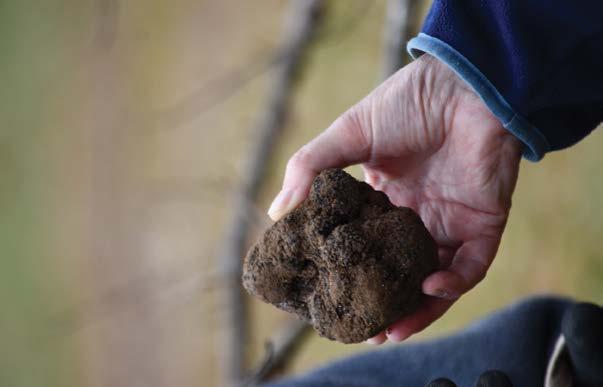

PIEDMONTVIRGINIAN.COM | | AUTUMN 2022 23
FARM TO TABLE
(3)
regular harvest. Like Diana, John, a retired Motorola executive, decided he liked the truffle growing lifestyle, when he visited farms in Australia and New Zealand. The family bought a Virginia farm in 2007 and had their first crop in 2018, more than 10 years after they sowed their first spores. Daughter Olivia Taylor, who studied agriculture and truffle growing in France, now manages the farm.

Her first taste? “Truffles with scrambled eggs. It was divine.”
As soon as the weather grows cold, Olivia and her three dogs will prowl the grounds of their 26-acre farm. From the end of November to early March, they have daily visits of fanatical foodies who sometimes join the truffle hunt. Dogs are rewarded for smelling the truffle, helping to dig it up and NOT eating it so that Olivia can pull it up intact from the ground.
She carefully weighs the truffle, seals it and sends it in a special overnight mail container (or sometimes delivers it personally) to the Organic Butcher in McLean, or to be served at the Inn at Little Washington, Three Blacksmiths in Sperryville, Bastille in Alexandria, the Early Mountain Winery in Madison, Field and Main in Marshall, and L'Auberge Provencale in Boyce.
L'Auberge Provencale Chef Stephen Burke is a fan. “I love Olivia’s stuff. I just wish I could get them all the time.”
Lou Patierno at Girasole in The Plains is one of a number of chefs who would serve Virginia truffles if more were produced and they could depend on a regular supply. “We’ve done truffle dinners for every year,” Patierno says, “but we’ve focused specifically on the white Alba, which we get from Italy. No one has approached me yet about Virginia’s.”
This brings—at best—a sigh from Olivia Taylor, who will tell you that the fame of the Italian white Alba is due as much to the Italian Piedmont region’s aggressive promotion, through national and regional sponsored festivals and promotions, as its taste.
“The Virginia industry is pretty young and the Virginia Department of Agriculture has not expressed any interest in truffle culture. I’m not even sure we are on their radar.”
 CAMDEN LITTLETON (3)
CAMDEN LITTLETON (3)

24 PIEDMONTVIRGINIAN.COM | | AUTUMN 2022
FARM TO TABLE
Diana and Justin Hudson at their spring house in front of their planted and protected truffle generating trees in Hillsboro. Bottom: Aldo, Diana’s Lagotto Romagnolo, a breed of dog orignially bred in the 16th century to sniff ripening truffles.
Diana Duvall-Hudson’s Second Annual Truffle Festival will be held the first weekend of February, 2023. virginiatrufflefestival.org
BY
Dr. Don Detmer agrees. A University of Virginia Professor of Medical Education, surgeon and former vice president of the North American Truffle Growers Association, Dr. Detmer lives on a 34acre farm north of Crozet, where he has been waiting patiently for sixteen years for his first truffles to ripen.
“Seeking and gaining state interest and support [for truffle growers] has been a major challenge in Virginia,” he observes.




What is also challenging is inspiring the kind of scientific research that Dr. Detmer has seen in states such as Oregon, whose universities offer advanced degrees in mycology (the study of fungi). “Getting interest at universities in the state, and Virginia Tech in particular, has been frustrating and essentially a dead-end so far. Truffles are healthy and healthful and should be actively supported by the state, as is done in North Carolina, Michigan, Oregon, Idaho, and Canada.”
Dr. Charles LeFerver can attest to the effects of such support. The holder of a Ph.D. in forest mycology from Ohio State University, and a tireless promoter of domestic truffle growing, he has helped make Oregon the most famous and prolific truffle producing state in America. He is the author of an eye-opening feasibility study that suggests that, after an initial $15,000 per acre investment, a truffle farm could produce as much as $33,000 an acre of truffles every season.
Especially along Virginia’s Piedmont region. “The red soils that characterize Virginia’s Piedmont region are actually remarkably similar in essential ways to the French soils where the famous Périgord truffles grow naturally.”




Way back in 2006, Dr. LeFerver founded the Oregon Truffle Festival, the first truffle promotion event outside southern Europe. Since then the festival has celebrated the cultivation of a new truffle variety, the Appalachian (now being harvested in Maryland, Tennessee, and North Carolina), conducted blind tastings of American and European Périgord truffles (no difference!), and held a notorious 2018 truffle dog race in which a feisty Chihuahua named Gustave beat a pack of Lagottos to win first prize.
He is proud of his state and what he has accomplished in it. “Oregon is where the first inoculated [truffle] seedlings were produced outside of Europe. Oregon remains by far the largest producer of truffles in North America, and we’re working to reestablish the academic underpinnings of the industry. In the meantime, there are research programs on truffles underway at Michigan State, the University of Idaho, University of California Davis, North Carolina State University, and University of Florida. There is also academic interest at University of Kentucky.”
All of this explains why, in February 2021, Diana Duvall-Hudson held the first Virginia Truffle Festival on a weekend at Madison’s Early Mountain Winery. She admits that the covid pandemic, and a characteristic Blue Ridge blizzard, reduced attendance somewhat.
“But it was a start,” she says as she does the logistics for the second truffle fest (she’s asking truffle author Rowan Jacobsen to give a keynote speech). In November, she will join Olivia Taylor, Dr. Detmer, and others who attended her first truffle gathering, at the North American Truffle Growers Association meeting in Roanoke.
That she, Don Detmer, and other truffle growers in the state have yet to see a harvest has not blunted her resolve.



“I’m in this,” she says, “for the long haul.”


PIEDMONTVIRGINIAN.COM | | AUTUMN 2022 25
Homemade Truffle Butter
RECIPE AND PHOTOS BY KAITLIN HILL
If you manage to get your hands on some truffles, the possibilities of how to use them are endless. Simply shaved over pasta, melted in mashed potatoes, or even as a dessert like black truffle sabayon – the little mushroom is as versatile as it is delicious. An easy, impressive, and popular application is in homemade truffle butter which can be added to sauces or smeared across toast. If you are feeling adventurous, you can even make the butter from scratch as detailed below. Short on time? Simply bring a stick of unsalted butter to room temperature and mix in a little grated black truffle to add pizazz to any dish from breakfast to dinner. However you proceed, be prepared to use it frequently. Truffle butter is an instant crowd pleaser and easy recipe elevator.
MAKES: ½ CUP OF BUTTER TIME: 20 MINUTES


INGREDIENTS:
1 cup of heavy cream
¼ teaspoon of salt
1 small black truffle (about 1 tablespoon grated)
DIRECTIONS:
1. To make the butter, pour the cream into the bowl of a stand mixer fitted with a whisk attachment. Whip the butter on low until it starts to thicken and resemble whipped cream. This will take about 5 minutes. Turn the mixer to high and whip for another 5 – 7 minutes until the fat soilds separate from the liquid.
2. Drain the butter over a mesh sieve. Set the liquid aside but be sure to save it. This is homemade buttermilk. It can be used in all your baking recipes.
3. Rinse the butter by submerging it in a bowl of
cold water. Drain the water and repeat.
4. After the second rinse, drain all the water and, using your hands, press the butter into a ball. Using a zester, grate the black truffle into the butter and add the salt. Mix until the truffle and salt are evenly distributed throughout the butter.
5. At this point you can shape the butter into a stick and wrap in parchment paper or place into a small ramekin and cover the top with parchment paper for storage.
6. If kept in the fridge, the truffle butter can be enjoyed for up to one week – if it isn’t devoured before then!
26 PIEDMONTVIRGINIAN.COM | | AUTUMN 2022
FARM TO TABLE
ON VIEW
“Identity& Restraint”
A new exhibit at the National Sporting Library & Museum in Middleburg through March 2023 highlights the art of an essential canine accessory

“The dog collar
is, arguably, the oldest dog furnishing, and its purpose may be described as both one of identity and restraint. Since the domestication of canines, we have forged a strong bond with dogs — from hunting companions to sporting breeds as well as faithful pets. The dog collar is a symbol of the evolving relationship between humans and canines. The variety of styles that has developed over time — among them intimidating spiked metal rings, utilitarian pieces, elaborately jeweled works of art, and leather finery — show how we tamed, bred, claimed, and came to love our dogs.”
— National Sporting Library & Museum
ABOVE:
Oil
PIEDMONTVIRGINIAN.COM | | AUTUMN 2022 27
Zillah, Charles Hamilton (British, act. 1831–1867)
on mahogany panel, 16 1/2 x 21 inches; Gift of the Cynthia S. Wood Estate; American Kennel Club Museum of the Dog
“Identity & Restraint: Art of the Dog Collar” is an innovative traveling exhibition developed in partnership between the National Sporting Library & Museum (NSLM) and the American Kennel Club Museum of the Dog in New York. The show marries artwork spanning the 17th through 21st centuries
ABOVE: The Poacher at Bay Richard Ansdell, RA (British, 1815–1885)
Oil on canvas, 53 x 83 inches
Gift of Marie A. Moore, American Kennel Club Museum of the Dog

RIGHT: Dog Collar, Indian, possibly Goan, 18th century horsehide leather, brass mounds, and agate cabochons

11 x 3 inches
Gift of Dr. and Mrs. Timothy J. Greenan, 2014 National Sporting Library & Museum
with almost 70 vintage and antique dog collars from the NSLM’s collection. The largest publicly held holding of its kind, 187 collars were generously donated to the Middleburg museum by Dr. and Mrs. Timothy J. Greenan.
• For more information: nationalsporting.org
28 PIEDMONTVIRGINIAN.COM | | AUTUMN 2022 ON VIEW
ABOVE: The Amsterdam Dog Market, Abraham Hondius (Dutch, c. 1631–1691) Oil on canvas, 38 1/2 x 48 1/2 inches

Gift of Robert Flanders in Memory of Walter F. Goodman, on Loan from the American Kennel Club Museum of the Dog
LEFT: Dog Collar, Dutch, 1793, brass with modern felt lining 6 x 1 1/2 inches
Gift of Dr. and Mrs. Timothy J. Greenan, 2014 National Sporting Library & Museum

PIEDMONTVIRGINIAN.COM | | AUTUMN 2022 29
Saving Foxfield
It took vision, dedication, and keeping an eye on the plan
Albemarle County racecourse now protected in perpetuity thanks to its many ardent supporters
 BY BETSY BURKE PARKER
PHOTOS BY DOUGLAS LEES AND CAMDEN LITTLETON
BY BETSY BURKE PARKER
PHOTOS BY DOUGLAS LEES AND CAMDEN LITTLETON
EQUINE SPORTS
Horses in th $20,000 Handicap Hurdle Sponsored by Tiger Fuel & Beverage Tractor, Fall 2021
PHOTO BY CAMDEN LITTLETON
Tounderstand the heritage of Charlottesville's biggest biannual outdoor parties—the Foxfield Races are a seasonal rite, spring and fall—take a deep dive into the history of this magical property 10 minutes north of town.

From tailgaters to steeplechasers, from kids to co-eds, the event knits together alluring elements of thoroughbred competition and the purely social. To be sure, to most railbirds, the thundering hooves of the horses are mere background noise to what many call a perfect marriage of bacchanalia and al fresco gastronomy.
But to the horse owners and jockeys, it's serious business, with big prize money on the line. Both Foxfield meets are sanctioned by the National Steeplechase Association, the governing body for jump racing in America. Foxfield fans have been witness to some of the sport's best over the Garth Road course, including Hall of Fame 'chasers Zaccio, Victorian Hill, and Good Night Shirt, owned by Foxfield neighbor Sonny Via.
To the event's community and conservation-minded supporters, Foxfield has serious implications, too, with hundreds of thousands of dollars donated to beneficiaries from Service Dogs of Virginia to the Ron-
ald McDonald House over more than four decades since the first meet was held in 1978.
“Our corporate sponsorship, the Foxfield 500, is robust for this fall and supporters are enthusiastic about the races and community support,” said Foxfield Racing LLC executive director Kelsey Cox. “The community support from our sponsors has been tremendous for … our mission to conserve and connect with the community in a variety of ways. (We planned) lots of children's activities—truck touch with local community trucks for kids to explore, stick pony races, free pony rides and more.”
How'd it happen?
Hugh Garth's quiet Albemarle County cropland was spun onto a new trajectory when he sold it to early aviation entrepreneurs and graduates of the nearby University of Virginia in the late 1920s.
1981 Foxfield Races feature race
The Grand National #2. Zaccio (John Cushman, up)1st, and Sailor’s Clue (Woody Maloney, up) 2nd at the last fence. Zaccio would go on to his second Eclipse Award (2nd of three) in 1981.
One of Virginia's first public airfields—and one of just 31 in the commonwealth at the time—Wood Field opened with great fanfare in 1929. The Crozet Gazette reported that it took “…hundreds of field workers, dozens of tractors, and 40 mules” to tame the rolling Piedmont topography for the Dixie Flying Ser-

EQUINE SPORTS
PHOTO BY DOUGLAS LEES
of


Board

Megan Connolly, and Executive Director Tina
Executive Director Kelsey Cox hands over $50,000 to Dan Rosenweg, President & CEO of Habitat
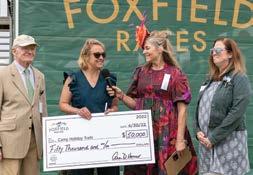

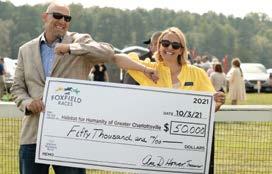
32 PIEDMONTVIRGINIAN.COM | | AUTUMN 2022
Clockwise from top left: This 1978 Eclipse photojournalist award winning photograph shows Mrs. R. H. Crompton III’s “Master’s Degree,” ridden by Buzzy Hannum during the timber race at the Foxfield Races. Horse and rider were unhurt. PHOTO BY DOUG LEES Horseman, author, and course designer Raymie Woolfe. PHOTO BY DOUG LEES Jank Sanford, Jr., Race Chairman, and R. Reynolds Cowles, Chairman of the Board.
PHOTO BY CAMDEN LITTLETON
Check presentation with Foxfield Chairman
the
Reynolds Cowles, Executive Director Kelsey Cox, Livestream Announcer
LaRouche, of Camp Holiday Trails. PHOTO BY CAMDEN LITTLETON
for Humanity.
PHOTO BY CAMDEN LITTLETON
William Faulkner and Farmington huntsman Grover Vandevender share a flask in the autumn of 1960.
PHOTO BY GEORGE BARKLEY, FAULKNER PAPERS
vice, flattening the high ground along what would later become Garth Road into three air strips.
A victim of terrible timing, as the Great Depression tightened its grip on the region and the world, Wood Field was shuttered in 1934. The new airport, CHO, opened in 1955 a few miles north of Wood Field.
The Vandevender family purchased the old Dixie Flying Service land, conveniently adjacent to the Farmington Hunt kennels where local horseman Grover Vandevender was huntsman. According to many reports and memories of those who rode with him, Vandevender was popular and fun, setting up the family's Fox Fields farm as part equestrian venue, part social club for area and visiting riders, and foxhunters.
One of his more famous riders was Pulitzer-Prize winning author William Faulkner when he was writer-in-residence at UVa. Another longtime client and close friend, Mariann de Tejeda, was a California shipping heiress who had the means to play a pivotal role in the future of the property.
De Tejeda was a thoroughbred horse owner, businesswoman, and entrepreneur, says Tom Dick, former president of the Foxfield Racing Association. “She considered herself a true Virginian despite having been raised in California.



“Her love affair with Foxfield—Fox Fields back then—started in the late ‘60s from riding (there) with her dear friend, and some
say the love of her life, Grover Vandevender,” Dick said. “It was Grover and Mariann's dream to some day run steeplechase races at Fox Fields.






Mariann…promised Grover that some day she would do just that.” And she did.
Together, they'd mapped out where the course would go: lefthanded, down around the farm pond and up to what would become the homestretch area where the old airstrips were. They even had plans for the one remaining hangar, located between Garth Road and what would become the top of the clubhouse turn.
Vandevender died in 1974, never getting to hear the call to the post, but de Tejeda marshaled on alone, buying the property from Vandevender’s heirs and contracting local horseman, author, and course designer Raymie Woolfe to coax a mile-long oval with two backstretch “chutes” out of the land much as the mule teams had breathed life into the airport runways.



Woolfe used the natural topography, saying it allowed for wellcanted turns, long straightaways that favored the speed and jumping ability of great steeplechasers, while at the same time providing outstanding views from every vantage point on and around the course.
“There’s something for everybody here,” said Foxfield Racing LLC director Reynolds Cowles. “From a tailgate party for peoplewatching, to a big card of good racing and some really good horses, Foxfield really delivers.”










PIEDMONTVIRGINIAN.COM | | AUTUMN 2022 33 #Give #GivewithBoCC campaign and he #G For more information please call #GiveWithBOCC For more informatio (800)-650-8 or visit 530 Black Warrenton, VA OCC WWW BANKOFCLARKE BANK
of 2022, our branches have designated a charity they are supporting. Follow the #GivewithBoCC campaign and help together by giving to these local charities. For more information please call (800)-650-8723 or visit 530 Blackwell Road Warrenton, VA 20186
the rest of 2022, our branches have designated a charity they are supporting. Follow the help together by giving to these local charities. #GiveWithBOC
the rest of 2022, our branches have designated a charit #GivewithBoCC campaign and help together by givi Please contact us with story ideas, photo submissions, article reactions, comments, questions or upcoming events that would interest our readers. We want to hear from you
instagram.com/thepiedmontvirginian
rest
For
For
pam@piedmontpub.com | 540-349-2951 | piedmontvirginian.com facebook.com/thepiedmontvirginian |
EQUINE SPORTS


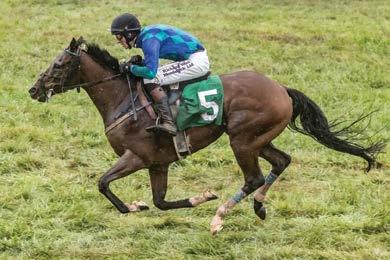
34 PIEDMONTVIRGINIAN.COM | | AUTUMN 2022 EQUINE SPORTS
Right: “Fast Vision,” ridden by Freddie Procter, trained by Leslie F. Young, winner of the Fall 2022 Amateur Rider Hurdle sponsored by Flow Audi of Charlottesville
Below: Stick pony races are a highlight at the Fall Races
PHOTOS BY CAMDEN LITTLETON
The first Foxfield Races were held in 1978. With the exception of the Covid-canceled meets in 2020, races have been held there spring and fall ever since. De Tejeda remained an active part of race management until her death in 1983.

She's buried on the property.

De Tejeda clearly outlined her vision and legacy, and the future of the venue, in her will: “I have but one wish for the remainder of my lifetime and after my death,” she wrote, “and that is to apply all my time, energies, and financial resources to the perpetuation of the Foxfield Races.”



“It was her vision that the Foxfield Races have a forever home,” explained Cowles. She created the course and the events for the “recreation, education, and enjoyment of the people of Albemarle. It’s our job to see that her vision continues.”
The 178-acre property was recently protected in perpetuity, open land to remain open forever through a conservation easement held by the Albemarle Conservation Easement Authority. Foxfield joins some 104,000 protected acres—almost a quarter of the land in Albemarle County.
The dedication to de Tejeda’s vision has paid off. This year’s spring races were bigger and better than ever, say organizers, with a capacity crowd and full entries on a sparkling April afternoon. And the fall meet, tabbed as the Foxfield Family Day, added even more activities, even more vendors and even more racing, including the meet’s very first junior races at what the event director calls “the perfect autumn activity for Charlottesville-area families.”
It's exactly what de Tejeda envisioned, adds executive director Cox, horse racing coupled with outdoor recreation in support of the local community.
Last fall, Foxfield donated $50,000 to Habitat for Humanity of Charlottesville; this spring they gave $53,000 to Camp Holiday Trails.

“Community support through sponsorships and attendance not only helps our philanthropic partners, but allows them to spread (this) important mission to the community,” Cox added.
“We're grateful for the concerted and collaborative efforts (to) continue the tradition of Foxfield Races,” said Cowles.

PIEDMONTVIRGINIAN.COM | | AUTUMN 2022 35 40 Expires 5/31/15. Must present offer at time of rental. May not be combined with other offers or promotions. One offer per person. Your Tux Rental 524 Fletcher Dr. (Harris Teeter Shopping Center) 540.341.8840 | warrentonjewelers.com 524 Fletcher Drive Warrenton, VA 540.341.8840 warrentonjewelers.com Quality Service Selection enjoy $40 off your tux rental. Stop in today! Want to Look Like a Million at Prom? $40 Expires 5/31/15. Must present offer at time of rental. May not be combined with other offers or promotions. One offer per person. More Than a Jewelry Store combined with other offers or promotions. One offer per person. Stop in and see our new selection of Michou! EQUINE SPORTS
When the Rodeo Comes to Town
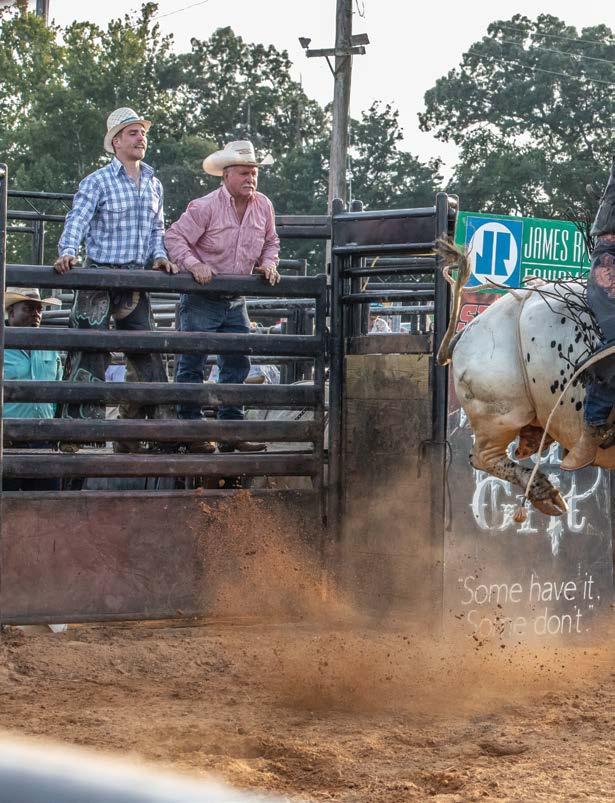
Culpeper’s inaugural event was a rip-snorter!
 BY DIANE FARINEAU
PHOTOS BY CAMDEN LITTLETON
BY DIANE FARINEAU
PHOTOS BY CAMDEN LITTLETON
EQUINE SPORTS

 Catching air right out of the gate
Catching air right out of the gate




38 PIEDMONTVIRGINIAN.COM | | AUTUMN 2022
“Laaaaaaaaaaaadies and gentlemen, are you ready to meet your cowboys and cowgirls?!”
Under the setting sun on a warm, clear September night, the town of Culpeper hosted its first, (and hopefully annual) professional rodeo. Close to 6,000 spectators sat on tailgates or lawn chairs overlooking a newly graded arena behind the barns at Culpeper Agricultural Enterprises. They were treated to an evening of breathtaking and heart-pounding bull riding and barrel racing.
The event was sponsored by Identity Culpeper, a nonprofit organization founded by former Culpeper Town Council member Jon Russell to increase tourism, youth engagement, and entrepreneurism in the area. Russell is deeply invested in his town, especially in creating opportunities for its children. He also started the Kelly Street Boxing Club, another nonprofit organization that offers boxing and life skills training for local boys who are primarily from single parent households. The rodeo served as the flagship fundraiser for the boxing club with the goal of underwriting a new boxing ring.
When asked how he arrived at the idea of a rodeo, Russell shared that, while there have been several visiting rodeos in the past, “…the Piedmont valley is known for our horses. It only makes sense that we would have a well-established annual rodeo that represents the community and region, something we can look forward to, plan around, and draw visitors to the area for this event.” Tickets were sold as far as Texas and Washington State, but the bulk of attendees were local and from Northern and Eastern Virginia.
The evening opened with the introduction of its 80 participants accompanied by a prayer for safety, pyrotechnics, and a presentation of the flag by the synchronized Liberty Hall mounted color guard. The Star Spangled Banner was sung by Eve Russell, followed by recognition of attendees and participants who were members of law enforcement, firefighters, EMS, and military veterans, staying on the theme of celebrating community. “Rodeo is something the whole family can enjoy,” said Russell. “It also represents Culpeper’s working-class roots and pride in this agrarian community.”
True Grit Rodeo, a full-service rodeo company based in Hurt, Va., produced the event, providing logistics and safety requirements, staff, and the bulls, plus organizing riders for a smooth and exciting lineup. Owner and announcer Daniel Lanier, along with comic relief cowboy clown Keegan Mayo, ensured there was never a dull
moment as they announced the riders, bulls, and scores, and occasionally dispensed a little urgent advice to those who might not have landed on their feet. “Get UP cowboy….and RUN!”

All events were sanctioned by either the Southern Extreme Bull Riders Association and International Miniature Bull Riders Association (IMBA), meaning riders earned points toward national standings. Bull hands from far and wide got two turns to try to make it the required eight seconds and in so doing, rack up championship points in what was the eighth stop on the IMBA tour.
The Jackson brothers, Nicholas, 14, and Dylan, 9, from Maryland, both turned in great rides. “These boys are fifth generation cowboys, so it was a natural progression to bull riding,” their father Corey said. When asked if he was nervous about watching his boys compete he said, “Not really. I’ve gotten used to it. Our thing is preparation. We put a lot of time into it, so when you prepare, success is a byproduct. But we believe in the Lord, and pray.”

His faith was rewarded as Nic won the evening’s top prize in the Rookie Division. Punctuating the two rounds of bull riding was the barrel racing event. Cowgirl Kim Kulenguski took top honors in the barrel racing, riding her cowpony Jack around the ring in 14 seconds flat.
In the warm-up paddock, riders joked with one another, practiced their grips, and rehearsed their arm motions in excited anticipation.

PIEDMONTVIRGINIAN.COM | | AUTUMN 2022 39
Above: The clown and the cowboy trying to get the bull back in the chute.
Far left: Event Organizer Jon Russell with wife, kids and members of Kelly Street Boxing club.
Left: True Grit Rodeo owner and announcer Daniel Lanier
EQUINE SPORTS
Right: Fifth-generation cowboys Nicolas and Dylan Jackson



40 PIEDMONTVIRGINIAN.COM | | AUTUMN 2022
Once the action was underway, they demonstrated a lot of camaraderie, cheering each other on as they entered the shoot and got settled on a bull. Lanier waited patiently for each rider to give the nod before the gate was opened and the bulls got the opportunity to toss their riders. True Grit photographer Charlotte Camp, who travels to most of the rodeo events (and demonstrated impressive fence-scrambling skills when her perch on the rail was a little too close to the action) explained, “The harness they use to secure the rider to the bull doesn’t wrap around any of the bull’s organs. It’s really just like a saddle, but they do find it irritating so they want to get it off.”
Families came out early to get a good spot (though there was no bad seat in the house as a result of good site planning and layout), get something to eat from one of the food trucks, visit sponsor booths, and take a good look at the bulls and riders. The True Grit team invited kids to race stick ponies around barrels or try out on a practice “bull” in the arena.
“I’m trying to be a cowboy!” 6-year-old Benjamin Thompson from Westmoreland said as he enjoyed his turn. Ben and his family were also

there to watch Ben’s friend Bubba Knapp compete in the IMBA round. A crowd favorite in his red leather chaps with white fringe, Bubba treated the audience to a little post ride dance after safely dismounting his mini mount.
His father shared that Bubba had been riding for about a year and was hoping to make it to the world championships in Reno, Nev., later this year. While the prizes for top riders were significant, $500-to-$5,000, audience members got to experience the thrills and chills for next to nothing. Albemarle County farmer Lisa Wildman brought her husband and daughter to the event. A native of Houston, this was not her first, or largest rodeo, but, “…it was the perfect size — easy to get here, plenty of parking, and we got to see all the action up close. We had a fun night!”
“I was very pleased with the turnout”, said Russell. “The best thing was the peace over the crowd — families all sitting together and just enjoying each other. Looking forward, I think we’re in a better spot to improve on the show and the accommodations for next year.”
It’s probably a safe bet to go ahead and mark your calendars for the second annual Culpeper Rodeo, Labor Day 2023.


PIEDMONTVIRGINIAN.COM | | AUTUMN 2022 41 Management Advisory Services | Tailored Engagements Tax Planning | Controller Services John W. Adams III, C.P.A., P.C. Corporate Accounting and Advisory Services 540-937-6450 | 703-777-6900 | john@jwacpa.com
Left: Little Cowboys and Cowgirls line up to ride the Mighty Bucky.
EQUINE SPORTS
Top: Cowgirl Kim Kulenguski and Jack, winners of barrel racing.
Building Schools Where There Were None
A dreamer’s plan to create educational opportunity was realized
BY GLENDA C. BOOTH
His Scrabble School teacher, Miss Williams, pushed her students hard, not just to learn the basics, but to love learning, recalls Col. Samuel Glasker, who grew up in Woodville, Rappahannock County. His parents could not read or write and his grandparents were enslaved. “I’m not that far from slavery,” Glasker commented. “What would I have achieved if I had not had that opportunity to read and write?”
Nan Butler Roberts, who lived in Sperryville as a youngster, also remembers the teachers’ high expectations. “Scrabble School is a testament to an amazing community of African Americans, who took hold of a dream that one day, their children's children's children would have opportunities that could only be accomplished by a real school with real teachers in a real classroom setting. Scrabble School provided all of those dreams that would come true for so many.”
The school, near Castleton in Rappahannock, was one of 382 Rosenwald Schools and associated facilities built in 79 of Virginia’s counties. Julius Rosenwald helped build 5,357 educational facilities in 15 states, from Maryland to Oklahoma between 1912 and 1932, providing almost 700,000 African American children in rural communities with schools at a time when the government at all levels provided little to no public money for their education.

According to a 2019 Preservation Virginia survey, 126 former Rosenwald Schools are still standing in the state; 256 are gone.

A Generous Philanthropist
Julius Rosenwald, the son of German Jewish immigrants, moved from Springfield, Ill., to New York City in 1878 at age 16 without finishing high school to learn the clothing trade. In 1885, he started a company in Chicago making men’s suits and came to know a fledgling, largely mail-order company called Sears, Roebuck and Co. He eventually became president of Sears, serving from 1908 to 1924, turned the company into a thriving powerhouse, and accumulated a fortune of more than $200 million (approximately $3.2
billion in 2022 dollars).
Believing in the Jewish concepts of tikkun olam (“repair the world”) and tzedakah (“righteousness, charity, and responsibility”), Rosenwald espoused a “give-while-you-live” philosophy, contending, “It is a crime to pile up money after one has accumulated all that he needs for himself and his family. There is a stage where acquisition becomes a vice.”
In 1911, he befriended Booker T. Washington, founder of Alabama’s Tuskegee Institute, joined Tuskegee’s board and raised money to build six rural Alabama schools. In 1917, he created the Rosenwald Fund and formed partnerships that combined grants and local donations to build school facilities across the South. While generous and public spirited, he believed that local people should help finance the schools, too.
42 PIEDMONTVIRGINIAN.COM | | AUTUMN 2022 HISTORY
COURTESY OF THE VIRGINIA DEPARTMENT OF HISTORIC RESOURCES
Scrabble School
After public schools desegregated, the Rosenwald Schools eventually closed, Scrabble in 1968. Sitting abandoned and in disrepair for many years with garbage bins out front, the property became a dumping ground. The late E. Franklin Warner drove by frequently and knowing that it had meaning for many people, organized other alumni and launched the Scrabble School Preservation Foundation to restore the building. In 2009, it reopened as the Rappahannock African American Heritage Center and a senior center.
Most of the Virginia Rosenwald Schools were one-story, wooden frame buildings and followed a one- or two-teacher plan, with the two-teacher plan, like Scrabble’s, most common. The school had a movable partition in the middle so that first- through third-graders sat on one side and fourth through seventh on the other. There was no cleaning staff and the “bathroom” was an outhouse. Students kept the wood or coal burning in the potbelly stove. Parents often brought lunch and snacks. Scrabble’s teachers commuted every week and boarded with local families.

St. John School
Ellen Douglas was in the first class of the St. John School in Albemarle County when it opened in 1922-23. Her daughter, Rebecca, now Kinney, went there in the school’s last two years, 1953 and 1954.
St. John is also a one-story, wood-frame building with the twoteacher design that served the African American community in the Cobham and Gordonsville areas. The Rosenwald Fund contributed $700, the local African American community, $400, and the local white community, $100. The Albemarle County School Board provided another $1,200.
After the school closed, it was a private residence until 2003 when the St. John Baptist Church next door bought the property. When church members were considering demolishing the building to expand their parking lot, Kinney and other school alumni held a reunion in 2009 and convinced the church’s leaders to preserve it. They organized as the St. John Family and Fitness Center, prepared the historic designation nominations, got a state marker installed, and

PIEDMONTVIRGINIAN.COM | | AUTUMN 2022 43 HISTORY
Scrabble School, Rappahannock County, now restored and used as a community center.
COURTESY OF THE VIRGINIA DEPARTMENT OF HISTORIC RESOURCES
started raising funds to restore the building as a community center.
Charlottesville’s Building Goodness Foundation’s volunteers are now doing the preservation and construction work and hope for a spring 2023 opening.
Why care? Team member Joseph Lahendro, a historic preservation architect, offers, “This is a window into our past, a reminder of something that we should never forget as a culture, the road for African Americans getting their education, wanting it so badly and working so hard to get it, with a little help from others, during the time of Jim Crow when there was very little opportunity.”
For Kinney, St. John School is “in her blood.”
“It’s important to continue the legacy,” she says, “not only for me but for the many alumni who are in the area.”
Shady Grove School
In the 1920s, Louisa-area African Americans organized a patrons' league and campaigned for a new school to replace the inadequate facility then in use. Shady Grove School, using the oneteacher plan, opened on donated land near a rural crossroads called Gum Spring in 1925 for students in grades one through seven. African American community members contributed $700; Louisa County, $400, and the Rosenwald Fund, $400. Shady Grove School closed in 1962.
Today, the original manual water pump still stands between the building and the road. In its heyday, the school had two outdoor privies for girls and boys. Former students recall walking to school
in all kinds of weather, doing housekeeping chores, gathering wood, hauling water, and getting a teacher’s ruler slap on the hand for misbehaving.
The Shady Grove (Rosenwald) School, Inc., Foundation raised funds to restore the school, which is now used for community events. They also convinced state officials to install a marker at the property.
“Shady Grove Schools is a well-preserved example of a rural Rosenwald school building . . . and preserves much of its original fabric with very little alteration,” says the historic designation nomination form. “. . . Shady Grove is a significant example of the impact of Virginia’s ‘separate but equal’ policy in education and the counterattack of the Julius Rosenwald Fund which sought to ‘raise up’ black youth through the power of education.”

Endangered
Preservation Virginia in 2013 listed Virginia’s Rosenwald Schools on the “Most Endangered Historic Places list and in 2019 completed an architectural survey of Virginia Rosenwald Schools in partnership with the Virginia Department of Historic Resources. The survey found that the counties with the heaviest population of Rosenwald Schools between 1917 and 1932 were Mecklenburg, Campbell, Pittsylvania, Halifax, Greensville, Charlotte, and Brunswick.
Marc Wagner, Senior Architectural Historian, with the Virginia Department of Historic Resources, lauds the effort: “The Rosenwald schools were islands of progress and enlightenment in the sea of Jim Crow oppression. These mostly small rural schools trans-
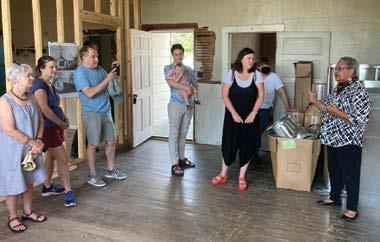
44 PIEDMONTVIRGINIAN.COM | | AUTUMN 2022
St. John’s School in 1984
COURTESY OF THE VIRGINIA DEPARTMENT OF HISTORIC RESOURCES
BY JOY LAHENDRO
BY JOY LAHENDRO
A suite of innovative products and services designed to improve lives and strengthen communities.




Whether you want to install panels on your property or take advantage of a hassle-free solar solution, REC has you covered.

REC has the tools, resources and solutions that current and future electric vehicle drivers need to power their ride.

PIEDMONTVIRGINIAN.COM | | AUTUMN 2022 45 HISTORY
Above: Becky Kinney giving a tour of St. John’s School for Preservation Piedmont. Right: “Community School Plans” 1920 booklet by Rosenwald Foundation, plan #20 used at St. John’s School.
LEARN MORE AT myrec.coop/ vividlybrighter
formed the lives of about two generations of African Americans. Preservation of Rosenwald Schools is a celebration of community and positive change.”
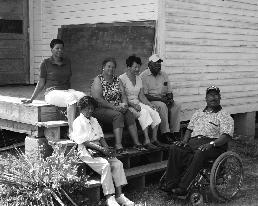
Of National Significance
The Rosenwald Schools National Historical Park Campaign is advocating for a new multi-state, national historic park to honor the Rosenwald Schools. The group recommended 56 school facilities for possible inclusion in the national park system, including the Shady Grove School. Shady Grove was one of ten schools included because, among other qualities, of its historic and architectural integrity and condition.
Advocates persuaded Congress to pass a bill, now law, the Julius Rosenwald and Rosenwald Schools Act of 2020, which requires the National Park Service to conduct a special resources study to determine if nationally significant resources are present and whether they are suitable and feasible additions to the national park system. The study is underway and will be completed in 2024. Supporters are also promoting a future visitor center in Chicago. The multi-state park would be the first national park to honor a Jewish American.
Dorothy Canter, founder and volunteer president of the campaign, devotes days to this cause. “This is the inspiring story of two little
known partnerships, the first between Booker T. Washington and Julius Rosenwald, that led to the construction of the first Rosenwald Schools in rural Alabama, the second between Rosenwald and the African American communities that thirsted for education for their children that led to nearly 5,000 Rosenwald Schools across 15 states in the Jim Crow South. A key example of how people worked together to make the nation better, it deserves to be preserved and told in a new national park, especially now,” she maintains.
INFORMATION
Rosenwald Schools National Historical Park Campaign: rosenwaldpark.org
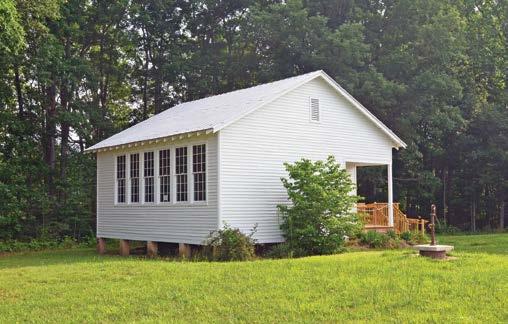
National Park Service, study: parkplanning.nps.gov/ projectHome.cfm?projectID=109936
Rosenwald Schools on the National Register of Historic Places: savingplaces.org/places/rosenwald-schools Preservation Virginia: preservationvirginia.org/ourwork/architectural-rosenwald-school-survey
46 PIEDMONTVIRGINIAN.COM | | AUTUMN 2022 HISTORY
“All the other pleasures of life seem to wear out, but the pleasure of helping others in distress never does.”
– JULIUS ROSENWALD
Shady Grove 2008 alumni group
COURTESY OF THE VIRGINIA DEPARTMENT OF HISTORIC RESOURCES
Finn
(1/11/2008 ~ 8/29/2022)
Dear Finn,
Remember the first time we met? I had seen your photo months before in a show dog newsletter, looking tall and fit and proud and kind. Then at that dog show in Michigan I spotted you easily in the parking lot, a head taller than every other Wirehaired Vizsla on the property. I knelt in front of you, held your face in my hands and said, “My God you are magnificent.” The second time we met, in a little park in Champagne, Illinois three years later, you looked at me with fondness and recognition. That’s how it felt, anyway. I know now that is simply how you looked at everyone you ever met. But at that meeting, after a quick private walk around the swing set and a quiet exchange of promises between us, your title was signed over to me, and you were mine.


I’ll never forget that first night with you in a hotel halfway home. I had changed your name, and called you Finn. In all our time together, in fact, I never once spoke your previous name aloud
in your presence. I wanted a fresh start. But I did wonder if you wondered, as I repeatedly called you the wrong name, if maybe I had accidentally picked up the wrong dog. But you adjusted to your new name, your new life and your new home as beautifully and simply as you adjusted to that night in the hotel room. I left you there for a half hour to pick us up a pizza and a six pack. I was worried you might be barking the whole time I was gone, but when I returned you were sitting on the bed, calm as could be, patiently waiting for me. We ate pizza and watched TV and I told you I would take good care of you. Then you slept on the bed, almost certainly for the first time in your life.
PIEDMONTVIRGINIAN.COM | | AUTUMN 2022 47 DOGS
STORY AND PHOTOS BY ED FELKER
When we got back to Virginia you met Winnie for the first time. I don’t remember the moment, but it was unremarkable. There has never been any drama with you, buddy. And in almost twelve years together, you and Winnie never had a single harsh word between you. You also never played together, which seems odd, but you both understood the assignment: You were a team. I called you ‘Team Orange,’ and you coexisted flawlessly together, albeit often in an old married couple kind of way.
Remember when I wondered, not knowing your background when I got you as a three year old, if maybe you could hunt? It’s certainly in your bloodline, I know that with certainty. But then we tried you on some birds and I figured maybe it skips a generation. No matter, buddy, I’ve never been disappointed in you a day in your life. We’d try something else. Everything else. Hiking, fishing, kayaking, camping, you loved all of it. You and Winnie got me moving, got me exploring and photographing and writing about nature. You literally changed my life in that very important regard.
Remember that Mud Run 5K we ran together at that festival in Richmond? God that was fun. The whole time I was running I watched you trot next to me and thought about how there had never been anything I’ve asked you to do that you pushed back on. We finished the race and wandered around the festival drinking beer and answering questions about you. Dozens of people were enthralled by the look of you, but it was more than that. They were drawn to you. People’s reaction to you at that festival was the catalyst that began your therapy dog career, a facet of dog ownership I had never explored before you.
Nursing homes and the VA Hospital became your official therapy assignments, and I’ve never been more proud of anything in my entire life than when I was watching you bring comfort to people who so desperately needed it. Once you got a taste for the work, you did it everywhere. To everyone. A visit to a brewery would result in five or six new “clients” of yours, folks just soothed by placing their hand on your head and looking at you.
Remember when you started losing your hearing? When you could no longer hear my voice from far away you would watch me for hand signals and come when I waved you in from the yard. Later your eyesight started to fail, but these are all part of the lucky, wonderful life with an older dog. Nevertheless, that’s when I retired you from official therapy work. Though you continued ‘freelancing’ at every opportunity.
Remember when your hind end started to get weak? You needed help getting in and out of the truck. In fact, lots of things were getting more difficult for you, but we figured it out. You couldn’t do stairs so we’d walk around the gentle slope of the backyard to get to the basement office so you could hang with me all day. You’d use the ramp I built for Winslow to get up and down from the porch to the yard. And we gave you supplements and medicine to keep you from being in pain.
You and Winnie and I grew old together. When the day came that

I knew we had to say goodbye to Winnie, the doctor came to the house. We put all the other dogs in another room, not wanting to complicate what came next. Except you, buddy. I know you don’t remember this part because you were asleep in a dog bed a couple feet away the whole time, but we were all glad you were there. I needed you there.
Remember the other day, when you lost your appetite and your energy? You still ate treats so I wasn’t panicked just yet. But the next morning, before that vet appointment, Mommy paused on her way out the door for work and lovingly put her hand on your head. This was not part of her routine, so I noted the gesture but pushed it away in my mind. Later, before we left, you wandered around the driveway to find new places to pee and I think you got a bit disoriented. You had the dog yard memorized, but out here, you lost your way a bit. I walked closer, and you know that fondness and recognition I mentioned earlier? Well I saw it in your face, but you couldn’t hear my voice. Your cloudy eyes couldn’t focus on my face. This time you just sensed me near, and smiled in your way. I touched your ear and you followed me to the truck and I lifted you in.
Remember how kind Dr. Carson was? But the news he brought was not kind. The words, the marks on the bloodwork printout, the X-rays, the symptoms, the age. The conclusion drawn was unmistakable. The decision made was one that I’ve dreaded since that night we shared a pizza in a hotel room and I promised you I would do right by you.
Remember the last vibration of a voice you felt in your ears? The last breath on your face, the last cheek, wet with tears, against yours? That was me, buddy. But you knew that. You never needed eyes or ears to feel my love.
You were more than my dog. You belonged to everyone who ever met you. How on earth do you say goodbye to the best dog you’ve ever met? Maybe you can’t. Maybe you have to just say, until we meet again.

48 PIEDMONTVIRGINIAN.COM | | AUTUMN 2022 DOGS
we
we


“I




nwonkdahewhsiwI“ about hospice sooner.”
Home is the most comfortable place of all, and the place to provide hospice care. The house you’ve lived in for decades, or an independent, skilled nursing or assisted living facility. Any patient, family member or friend can contact us anytime, 24/7.
place of all, and the best place to provide nursing assisted living facility. Any patient, family member or care. e house you’ve lived in for decades, or an independent, can contact us anytime, 24/7. Our staff lives and works here because caring for our community is our passion.
Home is the most comfortable place of all, and the place to provide hospice care. The house you’ve lived in for decades, or an independent, skilled nursing or assisted living facility. Any patient, family member or friend can contact us anytime, 24/7.
Home is the most comfortable place of all, in for decades, or an independent, skilled nursing friend can contact us anytime, 24/7.
Home is the most comfortable place of all, and the place to provide hospice care. The house you’ve lived in for decades, or an independent, skilled nursing or assisted living facility. Any patient, family member or friend can contact us anytime, 24/7.
Home is the most comfortable place of all, and the place to
place of all, and the best place to provide nursing assisted living facility. Any patient, family member or care. e house you’ve lived in for decades, or an independent, can contact us anytime, 24/7. Our staff lives and works here because caring for our community is our passion.
the most comfortable place of all, and the place to provide hospice care. The house you’ve lived decades, or an independent, skilled nursing or assisted living facility. Any patient, family member or contact us anytime, 24/7.
the place to provide hospice care. The house you’ve lived or assisted living facility. Any patient, family member or heartlandhospice.com/Warrenton
Home is the most comfortable place of all, and the place to provide hospice care. The house you’ve lived in for decades, or an independent, skilled nursing or assisted living facility. Any patient, family member or friend can contact us anytime, 24/7.
Home is the most comfortable place of all, in for decades, or an independent, skilled nursing friend can contact us anytime, 24/7.




400 Holiday Court • Suite 101
Home is the most comfortable place of all, and the place to provide hospice care. The house you’ve lived in for decades, or an independent, skilled nursing or assisted living facility. Any patient, family member or friend can contact us anytime, 24/7.
anytime, 24/7.

Home is the most comfortable place of all, and the place to provide hospice care. The house you’ve lived in for decades, or an independent, skilled nursing or assisted living facility. Any patient, family member or friend can contact us anytime, 24/7.
Warrenton, VA 20186
540.349.3970 | heartlandhospice.com/Warrenton
400 Holiday Court • Suite 101 Warrenton, VA 20186
493 Blackwell Road • Suite 319 Warrenton, VA 20186
Home is the most comfortable place of all, and the place to provide hospice care. The house you’ve lived in for decades, or an independent, skilled nursing or assisted living facility. Any patient, family member or friend can contact us anytime, 24/7.

540.349.3970 | heartlandhospice.com/Warrenton
the place to provide hospice care. The house you’ve lived or assisted living facility. Any patient, family member or heartlandhospice.com/Warrenton
540.349.3970 | heartlandhospice.com
540.349.3970 | heartlandhospice.com/Warrenton
540.349.3970
540.349.3970 | heartlandhospice.com
493 Blackwell Road • Suite 319 Warrenton, VA 20186
400 Holiday Court • Suite 101
540.349.3970 | www.heartlandhospice.com/warrenton
540.349.3970 | heartlandhospice.com/Warrenton
540.349.3970 | heartlandhospice.com/Warrenton
Warrenton, VA 20186
540.349.3970 | heartlandhospice.com/Warrenton
400 Holiday Court • Suite 101 Warrenton, VA 20186
540.349.3970 | www.heartlandhospice.com/warrenton
540.349.3970 | heartlandhospice.com
we
about
© 2019 HCR Healthcare, LLC
wish
had known
hospice sooner.”
we
known
hospice
LLC
wish we
hospice
the place all, and the
place . Any
member e house you’ve lived in
or an independent, . Our staff lives and works
hospice soone
“I wish
had
about
sooner.”
Home is the most comfortable place of all, and the place to provide hospice care. The house you’ve lived in for decades, or an independent, skilled nursing or assisted living facility. Any patient, family member “I
had known about
sooner.” me
best
patient, family
for decades,
www.heartlandhospice.com/warrenton
“I wish we had known about hospice sooner.”
known
wish “I about sooner.”
540.349.3970 | heartlandhospice.com
nwonkdahewhsiwI“ about hospice sooner.”
© 2019 HCR Healthcare, LLC
| heartlandhospice.com/Warrenton “I wish we had known about hospice sooner.”
“I wish
had known about hospice sooner.”
HCR-312985-001 © 2019 HCR Healthcare, LLC
provide hospice care. The house you’ve lived in for decades, or an independent, skilled nursing or assisted living facility. Any patient, family member or friend can contact us anytime, 24/7. 540.349.3970 | heartlandhospice.com/Warrenton “I wish we had known about hospice sooner.” © 2019 HCR Healthcare, LLC the most comfortable place of all, and the place to provide hospice care. The house you’ve lived decades, or an independent, skilled nursing or assisted living facility. Any patient, family member or contact us
“I wish we had known about hospice sooner.” LLC Home is the most comfortable place of all, and the
to provide hospice care. The house you’ve lived
an
nursing or assisted
Any patient, family member friend can contact us anytime, 24/7. 400 Holiday Court • Suite 101 Warrenton, VA 20186 540.349.3970 | heartlandhospice.com
wish we had known about hospice sooner.” the place all, and the best place assisted living facility. Any patient, family member e house you’ve lived in for decades, or an independent, contact anytime, Our staff lives and works because caring for our community is our passion. 493 Blackwell Road • Suite 319 Warrenton, VA 20186 540.349.3970 | www.heartlandhospice.com/warrenton we hospice soone
place
in for decades, or
independent, skilled
living facility.
“I
“I wish we had known about hospice sooner.”
known we wish “I about sooner.”
© 2019 HCR Healthcare, LLC
“I wish we had known about hospice sooner.”
“I wish we had known about hospice sooner.”
HCR-312985-001 © 2019 HCR Healthcare, LLC
A WORLD APART
Beauty, Serenity, Community, Arts, Library, Organic Farms, Country Stores, Fine Dining, Mountains, Farms, Rivers and the Shenandoah National Park. No stop lights, malls, data centers, or any other nonsense.





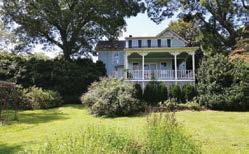

 220 acres with a 2 bedroom/ 2 bath cabin dating to 1875. Quite the find. SOLD
Personally designed with love, water features and view. Sorry to see you go. SOLD
A LADY IN WAITING – Style, beauty & privacy. Town of Washington VA
A view over the F. T. Valley to spectacular mountains. ODH for the horses. SOLD
Farm at the end of the road. Barns, fencing, views of night stars and mountains. SOLD
220 acres with a 2 bedroom/ 2 bath cabin dating to 1875. Quite the find. SOLD
Personally designed with love, water features and view. Sorry to see you go. SOLD
A LADY IN WAITING – Style, beauty & privacy. Town of Washington VA
A view over the F. T. Valley to spectacular mountains. ODH for the horses. SOLD
Farm at the end of the road. Barns, fencing, views of night stars and mountains. SOLD
Kaye Kohler ~ Rick Kohler www.KohlerRealtors.com 540.675.1373
Rappahannock history dating to 1833. Welcome to the county! SOLD





















 BY ED FELKER
BY ED FELKER
















 PHOTOS BY JENNIFER A TEPPER
PHOTOS BY JENNIFER A TEPPER

















 PHOTOS BY ERIN GIFFORD
PHOTOS BY ERIN GIFFORD



 STORY AND PHOTOS BY GLENDA C. BOOTH
STORY AND PHOTOS BY GLENDA C. BOOTH




















 CAMDEN LITTLETON (3)
CAMDEN LITTLETON (3)














 BY BETSY BURKE PARKER
PHOTOS BY DOUGLAS LEES AND CAMDEN LITTLETON
BY BETSY BURKE PARKER
PHOTOS BY DOUGLAS LEES AND CAMDEN LITTLETON



































 BY DIANE FARINEAU
PHOTOS BY CAMDEN LITTLETON
BY DIANE FARINEAU
PHOTOS BY CAMDEN LITTLETON

































 220 acres with a 2 bedroom/ 2 bath cabin dating to 1875. Quite the find. SOLD
Personally designed with love, water features and view. Sorry to see you go. SOLD
A LADY IN WAITING – Style, beauty & privacy. Town of Washington VA
A view over the F. T. Valley to spectacular mountains. ODH for the horses. SOLD
Farm at the end of the road. Barns, fencing, views of night stars and mountains. SOLD
220 acres with a 2 bedroom/ 2 bath cabin dating to 1875. Quite the find. SOLD
Personally designed with love, water features and view. Sorry to see you go. SOLD
A LADY IN WAITING – Style, beauty & privacy. Town of Washington VA
A view over the F. T. Valley to spectacular mountains. ODH for the horses. SOLD
Farm at the end of the road. Barns, fencing, views of night stars and mountains. SOLD